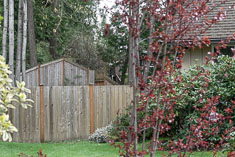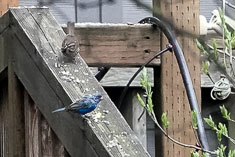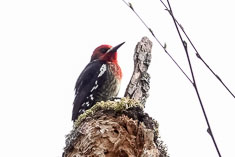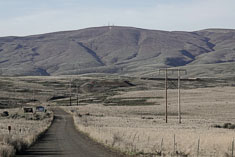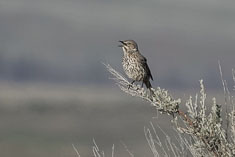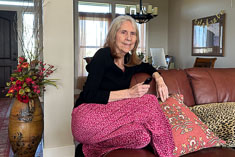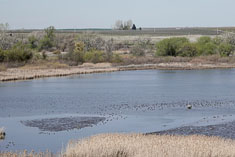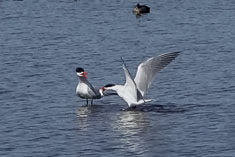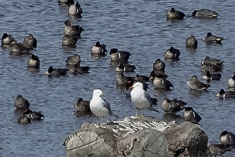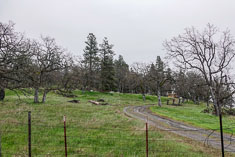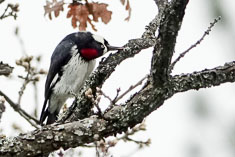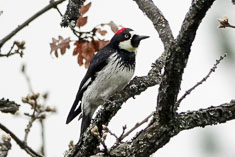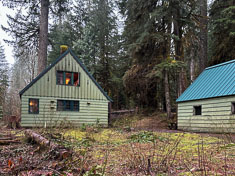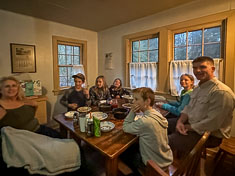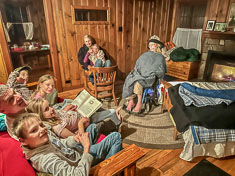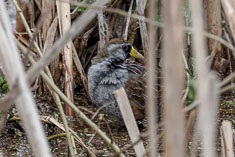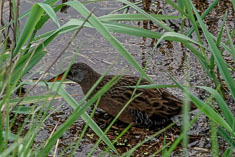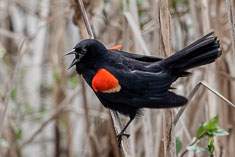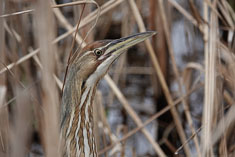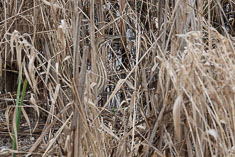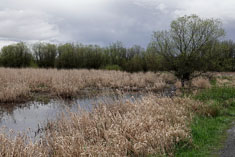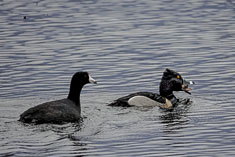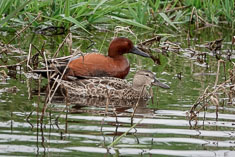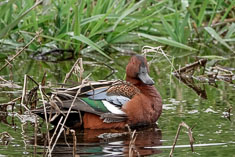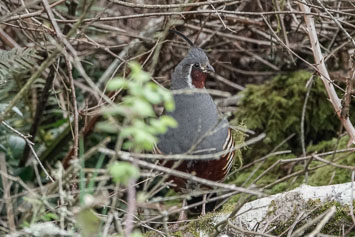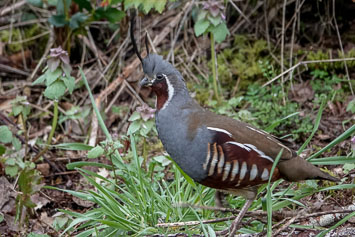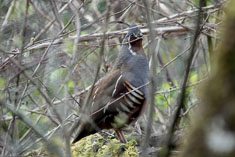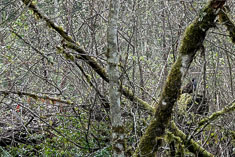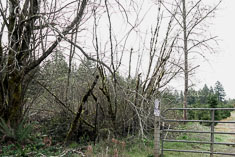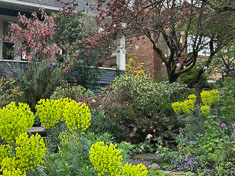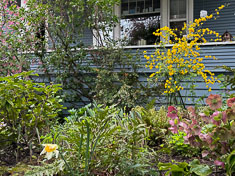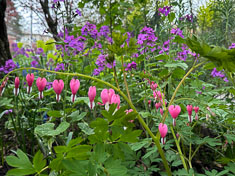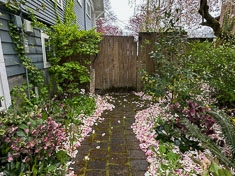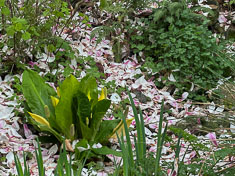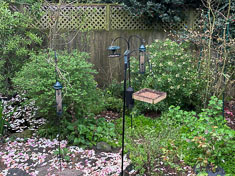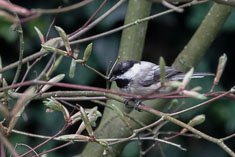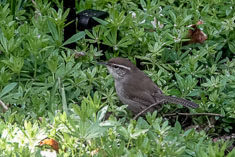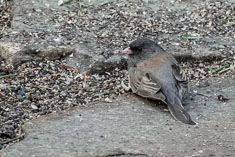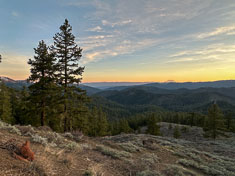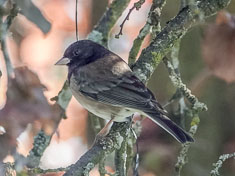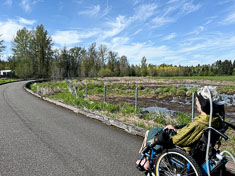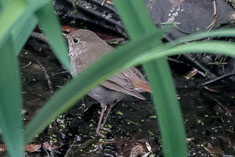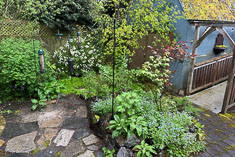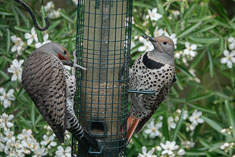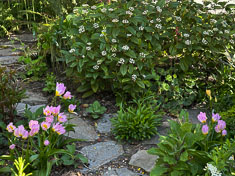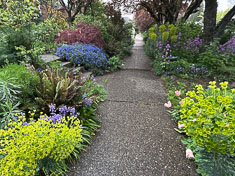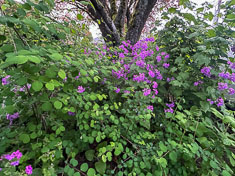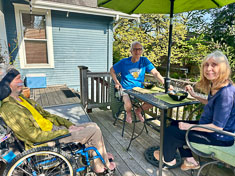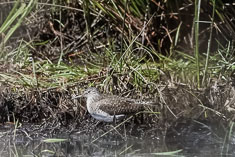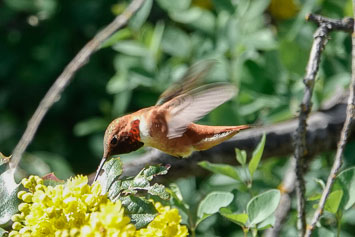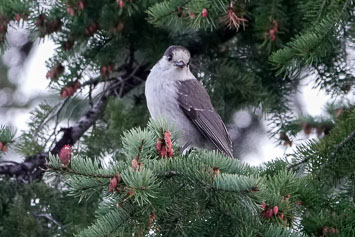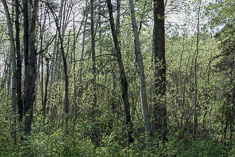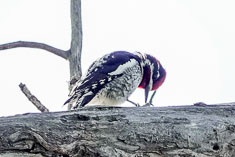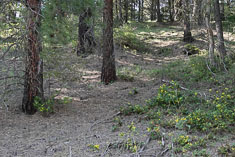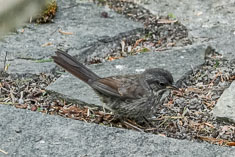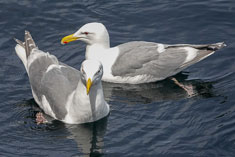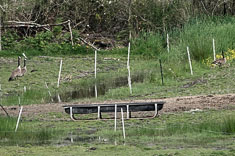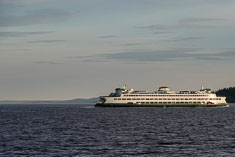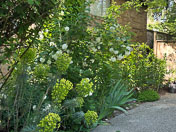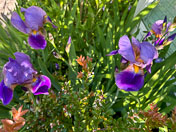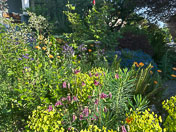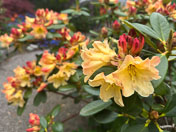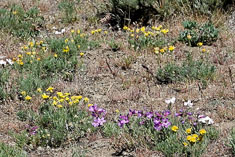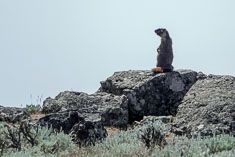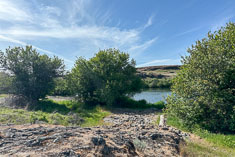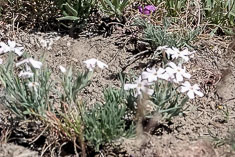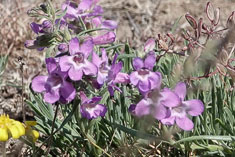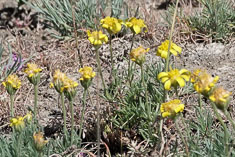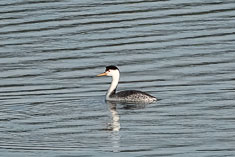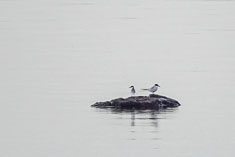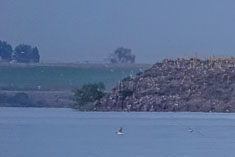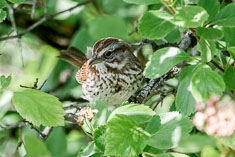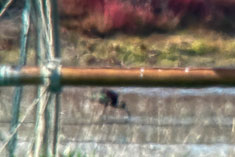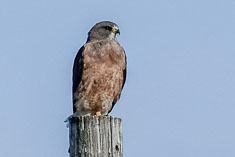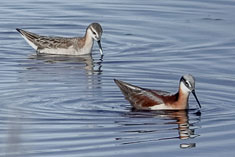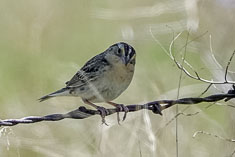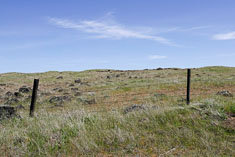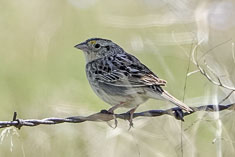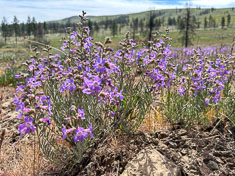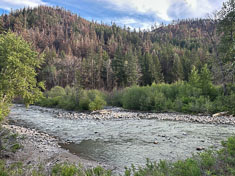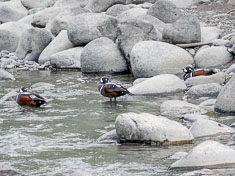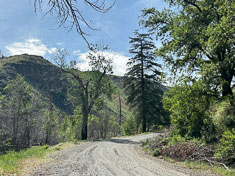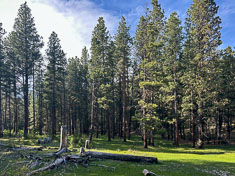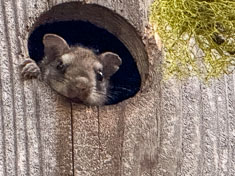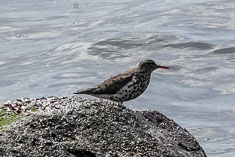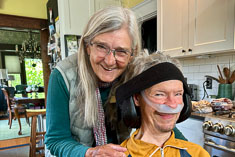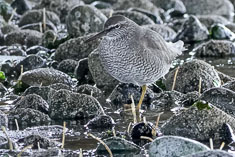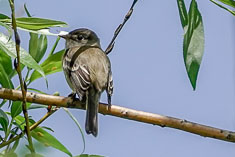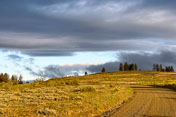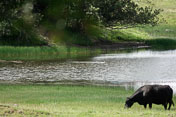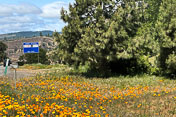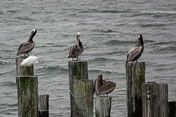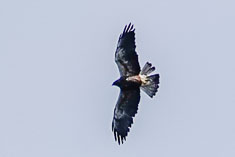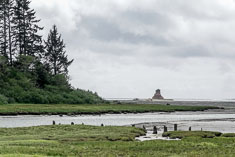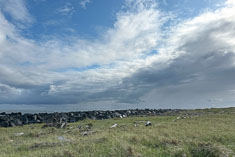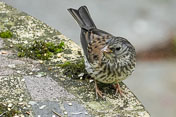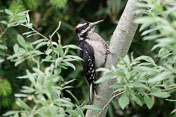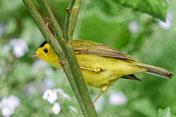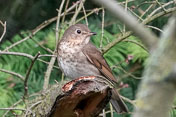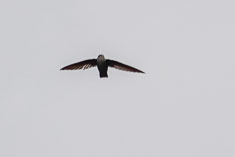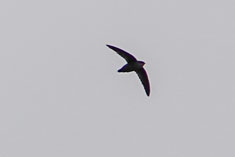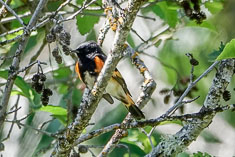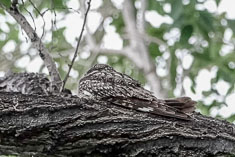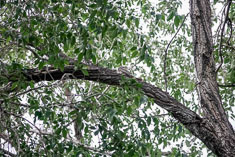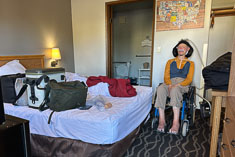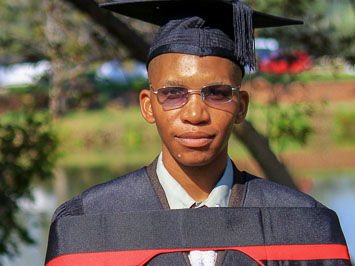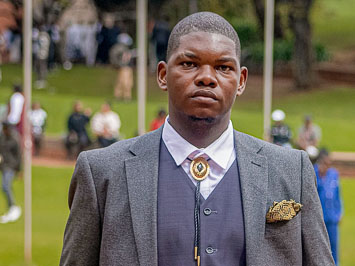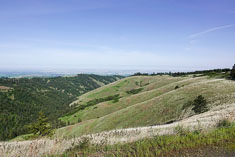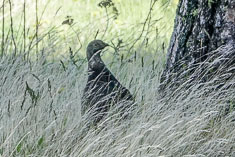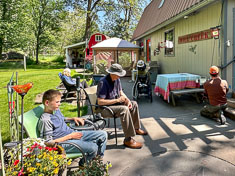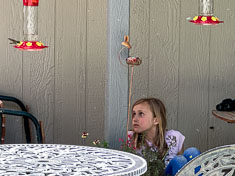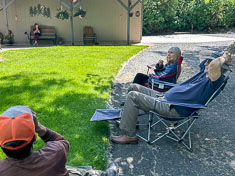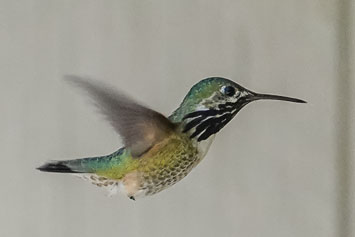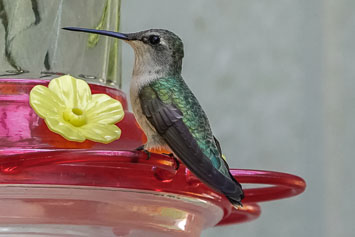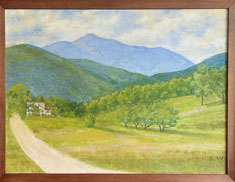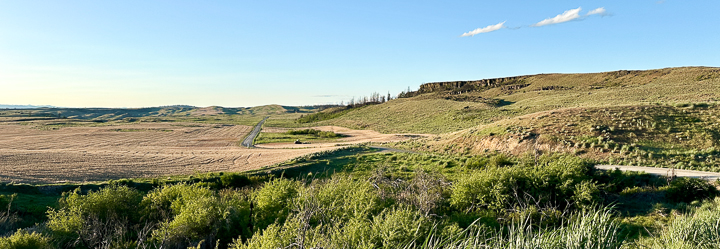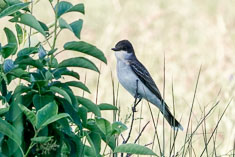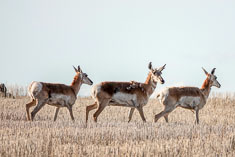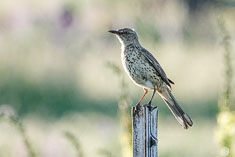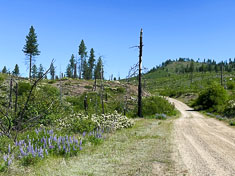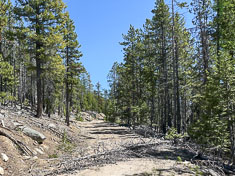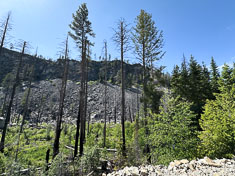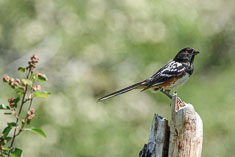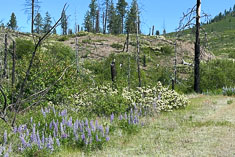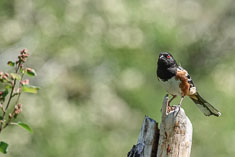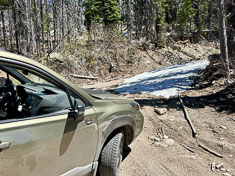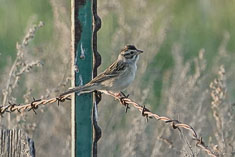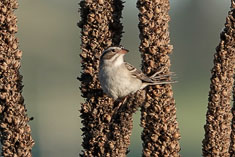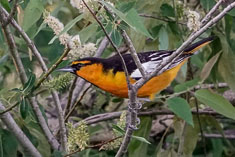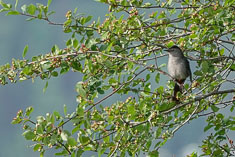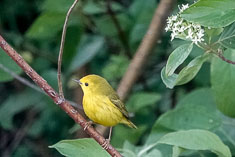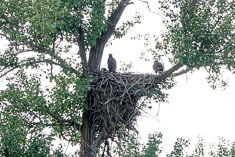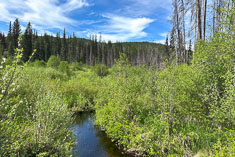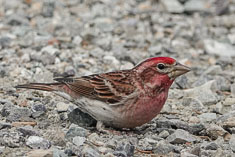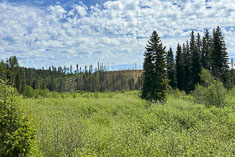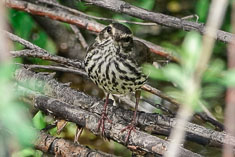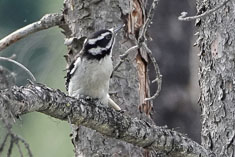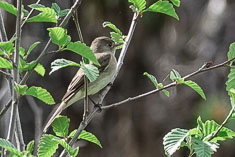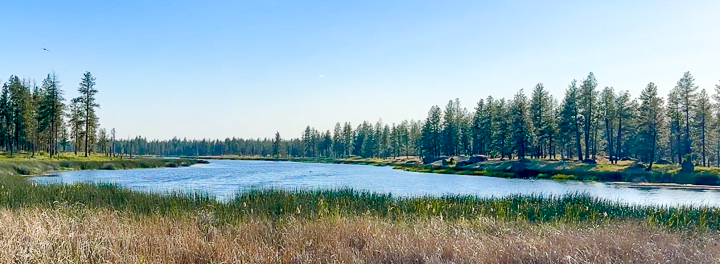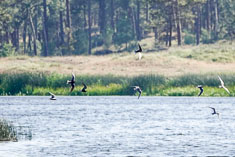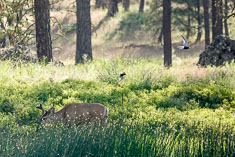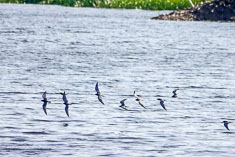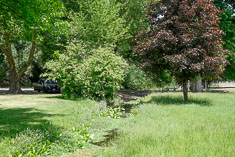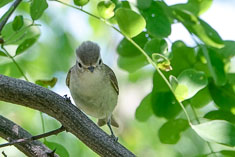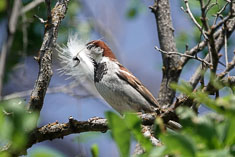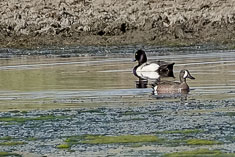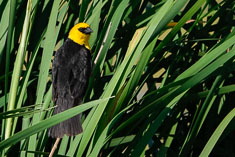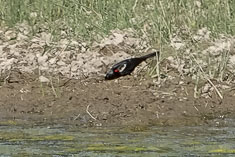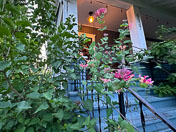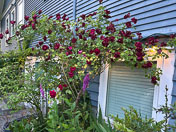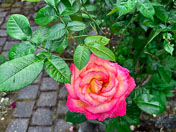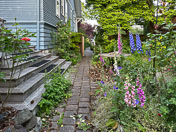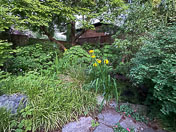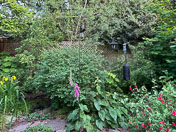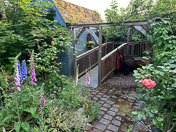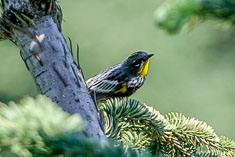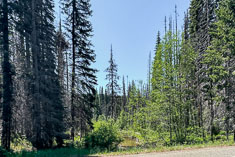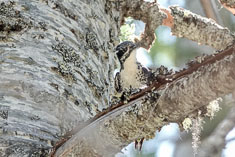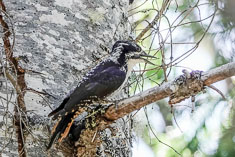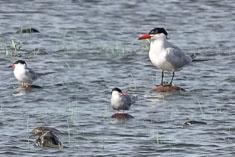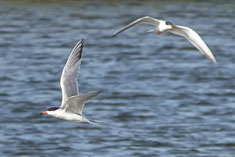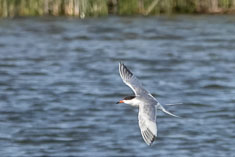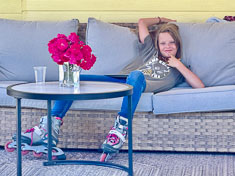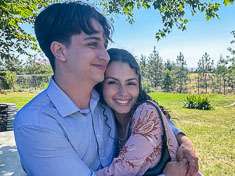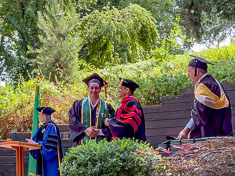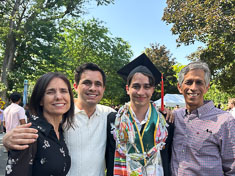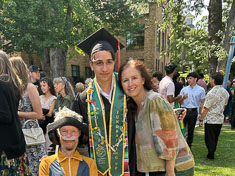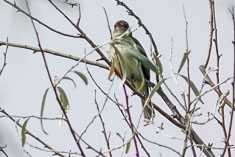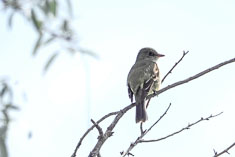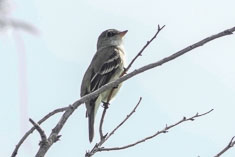4/02/2025 Indigo Bunting (link to here)
One of my favorite birds was reported in Issaquah a week ago. The Indigo Bunting is a gorgeous blue songbird which breeds across the eastern half of the country from Kansas to Maine. I first got to know it in New Hampshire during my first summer of birding 50 years ago, when I discovered through my casual observations that each individual in my rural neighborhood sang its own unique song. Using their songs I was able to determine the range of their summer wanderings (up to 0.7 miles) and that they returned to the same territories in successive summers. I regret now that I did not conduct a more rigorous study but I was not then and have never been since, a scientist at heart. I lack the discipline for research but I have since high school been fascinated by many aspects of the natural world, particularly flowers, birds and rocks - things with color that are large enough to see with the naked eye, like Indigo Buntings.
Anyhow the buntings winter mostly in Central America (some in Cuba and south Florida) from October to late April so if the Issaquah bird, a male mostly molted into breeding plumage, is a northbound migrant it is both far off course and abnormally early. Alternatively it might have overwintered at a feeder nearby. Eastern warblers, also neotropical migrants like the bunting but even less inclined to subsist on seeds, have been known to do that. Indigo Buntings are very rare in Washington but every two or three years one turns up in early summer, claims a territory and sings tirelessly to attract a mate. As far as I know none have succeeded though the bird over at Wenas Creek in 2017 was rumored to have paired up with a closely related Lazuli Bunting. Hybrids occur, and in my limited experience are never quite as beautiful as their parents.
Initially suspecting that the bird had been misidentified and subsequently concerned that it might be inaccessible, we weren't tempted to chase it but as more details emerged we yielded and made the 23 minute drive. Darchelle having done her research recognized the owner when he happened to come out to walk his dog just as we happened to pull up to his house. He was friendly and helpful, even inviting us to wheel around behind the house to watch for the bird. His feeder had fallen down and he had not seen the bird all morning but he offered to put out seed on his deck railings to improve our chances. Reluctant to go to the trouble of getting out of the car, I suggested that we try watching from the cul-de-sac around the corner L+, from which others had reported decent, though distant, views of the bird. That worked. After monitoring the deck railings for a half hour (Darchelle with binoculars and I through my opera glasses), we both spotted the very blue bird land on the railing.
We left a thank you note and a ten dollar donation for seed by the front door on our way out.
Being so close we stopped by Lake Sammamish State Park L+ on our way home and found our customary first-of-year Red-breasted Sapsucker.
One of my favorite birds was reported in Issaquah a week ago. The Indigo Bunting is a gorgeous blue songbird which breeds across the eastern half of the country from Kansas to Maine. I first got to know it in New Hampshire during my first summer of birding 50 years ago, when I discovered through my casual observations that each individual in my rural neighborhood sang its own unique song. Using their songs I was able to determine the range of their summer wanderings (up to 0.7 miles) and that they returned to the same territories in successive summers. I regret now that I did not conduct a more rigorous study but I was not then and have never been since, a scientist at heart. I lack the discipline for research but I have since high school been fascinated by many aspects of the natural world, particularly flowers, birds and rocks - things with color that are large enough to see with the naked eye, like Indigo Buntings.
Anyhow the buntings winter mostly in Central America (some in Cuba and south Florida) from October to late April so if the Issaquah bird, a male mostly molted into breeding plumage, is a northbound migrant it is both far off course and abnormally early. Alternatively it might have overwintered at a feeder nearby. Eastern warblers, also neotropical migrants like the bunting but even less inclined to subsist on seeds, have been known to do that. Indigo Buntings are very rare in Washington but every two or three years one turns up in early summer, claims a territory and sings tirelessly to attract a mate. As far as I know none have succeeded though the bird over at Wenas Creek in 2017 was rumored to have paired up with a closely related Lazuli Bunting. Hybrids occur, and in my limited experience are never quite as beautiful as their parents.
Initially suspecting that the bird had been misidentified and subsequently concerned that it might be inaccessible, we weren't tempted to chase it but as more details emerged we yielded and made the 23 minute drive. Darchelle having done her research recognized the owner when he happened to come out to walk his dog just as we happened to pull up to his house. He was friendly and helpful, even inviting us to wheel around behind the house to watch for the bird. His feeder had fallen down and he had not seen the bird all morning but he offered to put out seed on his deck railings to improve our chances. Reluctant to go to the trouble of getting out of the car, I suggested that we try watching from the cul-de-sac around the corner L+, from which others had reported decent, though distant, views of the bird. That worked. After monitoring the deck railings for a half hour (Darchelle with binoculars and I through my opera glasses), we both spotted the very blue bird land on the railing.
We left a thank you note and a ten dollar donation for seed by the front door on our way out.
Being so close we stopped by Lake Sammamish State Park L+ on our way home and found our customary first-of-year Red-breasted Sapsucker.
4/5/2025 Walla Walla (link to here)
Richard had a high school reunion in Vancouver but Donna didn't want to make the long drive and Sally was heading out of town with Ben and the kids, so we got up uncharacteristically early this morning and drove over to Walla Walla to keep Donna company. Of course there was some birding involved too, particularly on Durr Road L+ outside of Ellensburg where we hoped that the shrub-steppe birds which we missed a week ago in the wind and rain might be more active in the morning sunshine. They were, and we picked up the three sagebrush species we hadn't yet seen this year.
We also found a White-hroated Swift and a Cliff Swallow at the Selah Rest Area L+, both new and both summer nesters in the impressive cliffs below the overlook. On our way through Pasco Darchelle spotted a sixth new bird, the first Western Kingbird of the year not just for us but for the entire state. She had only a brief glimpse as it alighted on a sign above the freeway but a flycatcher with a gray back and bright yellow belly can't be much else. Our report was approved despite being two days earlier than the previous earliest arrival.
We had a pleasant visit. Darchelle watched church wih Donna while I fixed a few broken pages on the website, then after lunch I think we all took naps.
Richard had a high school reunion in Vancouver but Donna didn't want to make the long drive and Sally was heading out of town with Ben and the kids, so we got up uncharacteristically early this morning and drove over to Walla Walla to keep Donna company. Of course there was some birding involved too, particularly on Durr Road L+ outside of Ellensburg where we hoped that the shrub-steppe birds which we missed a week ago in the wind and rain might be more active in the morning sunshine. They were, and we picked up the three sagebrush species we hadn't yet seen this year.
We also found a White-hroated Swift and a Cliff Swallow at the Selah Rest Area L+, both new and both summer nesters in the impressive cliffs below the overlook. On our way through Pasco Darchelle spotted a sixth new bird, the first Western Kingbird of the year not just for us but for the entire state. She had only a brief glimpse as it alighted on a sign above the freeway but a flycatcher with a gray back and bright yellow belly can't be much else. Our report was approved despite being two days earlier than the previous earliest arrival.
We had a pleasant visit. Darchelle watched church wih Donna while I fixed a few broken pages on the website, then after lunch I think we all took naps.
4/6/2025 Lyle (link to here)
We didn't leave Walla Walla until after lunch. Richard ran or mostly walked the first Sunday of the month 2-mile time trial down at the track, averaging a respectable-for-his-age 16 minutes per mile. The rest of us stayed in bed until he got home then we all ate breakfast together. I squeezed in a little more eye-gaze time while Darchelle packed up and Richard napped.
In Wallula we stopped at the Whitetail Bay overlook L+ and found our first Caspian Terns of the
year. They've been around for two weeks now but we've missed them on our prior somewhat casual
attempts. This afternoon Darchelle caught the male in the act of offering his (prospective?) mate
a small fish, a behavior I've also seen in Black and perhaps Common Terns. It's a Tern family
tradition apparently.
Passing through Lyle we scored an Acorn Woodpecker for the year thanks to Maxine who'd reported
three at the Syncline Winery on Balch Road L+ a day or two earlier. They were still there. We did not see
any Lewis's Woodpeckers. An hour earlier I'd seen one along Hwy 14 some 50 miles to the east
but we had not stopped to confirm my ID because I was sure we'd find them in Lyle.
Sally, barely, had talked us into joining them for the night at the Government Mineral Springs Guard Station + back in the damp woods north of
Carson. Darchelle has had a sore back for several days now so I've been very anxious about
transfers, to the point that I've been trying to avoid using the toilet which in turn means
minimizing food intake, which Darchelle doesn't like because she worries about my weight getting
too low. Anyhow Sally assured us that she and Ben would be
happy to help with transfers, and I liked the idea of visiting Ridgefield on the way home tomorrow.
We would be going there soon one way or another and it's a shorter drive from Carson than from
Seattle.
My anxiety persisted through the evening and even after Darchelle and Sally got me safely settled into bed. I must have found something else to worry about but we were in bed long enough that I eventually got some sleep. In the morning Gracie, I think, made pancakes but we didn't stick around long enough to enjoy them, leaving instead just in time to find a cell signal near Carson and send a message for Sally before her 9 AM deadline.
We didn't leave Walla Walla until after lunch. Richard ran or mostly walked the first Sunday of the month 2-mile time trial down at the track, averaging a respectable-for-his-age 16 minutes per mile. The rest of us stayed in bed until he got home then we all ate breakfast together. I squeezed in a little more eye-gaze time while Darchelle packed up and Richard napped.
My anxiety persisted through the evening and even after Darchelle and Sally got me safely settled into bed. I must have found something else to worry about but we were in bed long enough that I eventually got some sleep. In the morning Gracie, I think, made pancakes but we didn't stick around long enough to enjoy them, leaving instead just in time to find a cell signal near Carson and send a message for Sally before her 9 AM deadline.
4/7/2025 Ridgefield (link to here)
The one bird we really wanted to see at Ridgefield NWR L+ was an American Bittern. We've seen at least one every year for the past decade but fewer in recent years since I've been in the wheelchair so we don't take it for granted. Ridgefield is not the only place in the state to see one from the car, but it unquestionably the easiest. Not for me today though.
Most of the Bittern habitat along the Ridgefield loop drive is on the driver's side of the car, and
so were both of the Bitterns that we, that is Darchelle, spotted. Darchelle was not able to
maneuver the car into a position from which I could see the first bird so we drove around again and
found a different individual, which I saw.
We also had good views of pairs of Cinnamon Teal, a striking bird albeit in my opinion not as attractive as its North American cousins. Blue-winged Teal are simply elegant and Green-wings are cute in their own earnest way whereas the bill on the Cinnamon is too large and the red eye gives the drake a perpetually startled expression.
The one bird we really wanted to see at Ridgefield NWR L+ was an American Bittern. We've seen at least one every year for the past decade but fewer in recent years since I've been in the wheelchair so we don't take it for granted. Ridgefield is not the only place in the state to see one from the car, but it unquestionably the easiest. Not for me today though.
We also had good views of pairs of Cinnamon Teal, a striking bird albeit in my opinion not as attractive as its North American cousins. Blue-winged Teal are simply elegant and Green-wings are cute in their own earnest way whereas the bill on the Cinnamon is too large and the red eye gives the drake a perpetually startled expression.
4/10/2025 Mountain Quail (link to here)
Like most of the other North American members of its family the Mountain Quail is a very good-looking bird, which makes it all the more disappointing that despite hearing them for the past four years in a row we haven't actually seen one since 2018. We used to see them annually at the Port Orchard Airport Quarry + but that location required a hike, and moreover the birds have not been reported there since 2022. At our alternate location, the 144 St PowerLine + northwest of Gig Harbor, I've been able to hear them from the car but they've always stayed out of sight. Until today.
Like the Northern Bobwhite, Mountain Quail are not native to western Washington but unlike the Bobwhite, they are widespread in Oregon right up to the south bank of the Columbia River. They evidently refuse to cross the water so in Washington they are native (though rare) only around the northern and eastern edges of the Blue Mountains where the river is not an obstacle. Perhaps this summer we'll try to find them over there.
Knowing that the quail are early risers, we tried to do likewise but seduced by an ultimately rather mediocre movie, we stayed up too late and didn't get to 144th Street NW L+ until almost 8 AM. Once on site we were birding our way up the road from 118th NW, reluctant to start really looking for the bird in case we'd have to acknowledge that we weren't going to get it, when we both heard two distant calls. The quail has a distinctive "qwierk" call which is not easily mistaken for any other local bird so we were confident of the ID and relieved to dodge being skunked. That's the problem with birding the way we do, chasing individual species; it's hard to relax and enjoy being out in nature until you get the bird. Once you do though, it's great.
We hailed Ed and Delia, who'd just returned to their car about a quarter mile up the road at the gate after an unsuccessful quest for the quail. Soon after they joined us they too heard the distant "qwierk"s. In years past we've mostly heard the birds beyond the gate where Ed and Delia had been searching but these calls were coming from off to our left, south of the powerline road in an area which appeared to be forested. Although I think of Mountain Quail as birds of chapparal, their primary requirement is dense brush, preferably with some tree cover along with small clearings. In western Washington they seem to favor Scotch Broom; their range corresponds well to those areas in the southern Puget Sound region where Scotch Broom is the dominant pioneer shrub in clearcuts. The satellite map M+ reveals that 144th Street NW fits that description, and that the quail we were hearing was probably calling from a plantation of young conifers just out of sight down a grassy double-track.
We followed the double-track through the brushy strip of woods along the powerline to a closed tube gate, parked there and listened. The calls were definitely closer now, not far off to our left along the edge of the young cedar plantation beyond the gate. With everyone's consent Darchelle played a few "qwierk" calls on her phone and suddenly the bird darted into view behind the gate. I didn't see it until it had retreated into the brush on our left, hopped up onto a mossy fallen limb and resumed calling, but at least I saw it, and both Darchelle and Ed got photos.
Like most of the other North American members of its family the Mountain Quail is a very good-looking bird, which makes it all the more disappointing that despite hearing them for the past four years in a row we haven't actually seen one since 2018. We used to see them annually at the Port Orchard Airport Quarry + but that location required a hike, and moreover the birds have not been reported there since 2022. At our alternate location, the 144 St PowerLine + northwest of Gig Harbor, I've been able to hear them from the car but they've always stayed out of sight. Until today.
Like the Northern Bobwhite, Mountain Quail are not native to western Washington but unlike the Bobwhite, they are widespread in Oregon right up to the south bank of the Columbia River. They evidently refuse to cross the water so in Washington they are native (though rare) only around the northern and eastern edges of the Blue Mountains where the river is not an obstacle. Perhaps this summer we'll try to find them over there.
Knowing that the quail are early risers, we tried to do likewise but seduced by an ultimately rather mediocre movie, we stayed up too late and didn't get to 144th Street NW L+ until almost 8 AM. Once on site we were birding our way up the road from 118th NW, reluctant to start really looking for the bird in case we'd have to acknowledge that we weren't going to get it, when we both heard two distant calls. The quail has a distinctive "qwierk" call which is not easily mistaken for any other local bird so we were confident of the ID and relieved to dodge being skunked. That's the problem with birding the way we do, chasing individual species; it's hard to relax and enjoy being out in nature until you get the bird. Once you do though, it's great.
We hailed Ed and Delia, who'd just returned to their car about a quarter mile up the road at the gate after an unsuccessful quest for the quail. Soon after they joined us they too heard the distant "qwierk"s. In years past we've mostly heard the birds beyond the gate where Ed and Delia had been searching but these calls were coming from off to our left, south of the powerline road in an area which appeared to be forested. Although I think of Mountain Quail as birds of chapparal, their primary requirement is dense brush, preferably with some tree cover along with small clearings. In western Washington they seem to favor Scotch Broom; their range corresponds well to those areas in the southern Puget Sound region where Scotch Broom is the dominant pioneer shrub in clearcuts. The satellite map M+ reveals that 144th Street NW fits that description, and that the quail we were hearing was probably calling from a plantation of young conifers just out of sight down a grassy double-track.
We followed the double-track through the brushy strip of woods along the powerline to a closed tube gate, parked there and listened. The calls were definitely closer now, not far off to our left along the edge of the young cedar plantation beyond the gate. With everyone's consent Darchelle played a few "qwierk" calls on her phone and suddenly the bird darted into view behind the gate. I didn't see it until it had retreated into the brush on our left, hopped up onto a mossy fallen limb and resumed calling, but at least I saw it, and both Darchelle and Ed got photos.
The Yard (link to here)
April is prime time for flowers in the yard so when we returned home from the Mountain Quail I asked
Darchelle to take a few photos.
The back yard is carpeted with Magnolia petals, a nice effect for a few days. Skunk Cabbage is blooming, along with Hellebore and Oregon Grape but not much else.
The back yard is carpeted with Magnolia petals, a nice effect for a few days. Skunk Cabbage is blooming, along with Hellebore and Oregon Grape but not much else.
4/12/2025 Home (link to here)
All three of the above species have established breeding territories which include our back yard with its feeders and source of water, but the leucistic chickadee appears to be an unattached male and the female junco appears to have an injured leg. I don't yet know if she is the female of our breeding pair, whose nest may again be located in the brushy median strip in front of the house.
All three of the above species have established breeding territories which include our back yard with its feeders and source of water, but the leucistic chickadee appears to be an unattached male and the female junco appears to have an injured leg. I don't yet know if she is the female of our breeding pair, whose nest may again be located in the brushy median strip in front of the house.
4/18/2025 Target Birds (link to here)
Yesterday afternoon we drove over to Liberty and spent several hours around sunset driving the forest roads north of town in hopes of hearing a Spotted Owl. If there are still a few in the area they eluded us again.
Today we chased a Solitary Sandpiper reported at the Evans Creek Trail L+ in Redmond, a new location for us. We missed the bird but liked the trail. It is paved and runs through fields, marshes and patches of riparian forest along the semi-rural south side of town. Today was a warm spring day and along the way trees were leafing out, bushes were flowering, birds were singing and ducks were paddling around pools of open water in the marsh. The two Greater Yellowlegs which had accompanied the Solitary Sandpiper several hours earlier were still foraging in the mud between the clumps of rushes and marsh grass, but the shorebird with them was not the Solitary Sandpiper but rather a third Greater Yellowlegs. We double-checked. On the other hand, several American Pipits were also foraging in the marsh so we did not leave empty-handed (or empty-listed?).
The Dark-eyed Junco which Darchelle photographed in the plum tree in front of the house is not one of our target birds, except perhaps on January 1.
Yesterday afternoon we drove over to Liberty and spent several hours around sunset driving the forest roads north of town in hopes of hearing a Spotted Owl. If there are still a few in the area they eluded us again.
Today we chased a Solitary Sandpiper reported at the Evans Creek Trail L+ in Redmond, a new location for us. We missed the bird but liked the trail. It is paved and runs through fields, marshes and patches of riparian forest along the semi-rural south side of town. Today was a warm spring day and along the way trees were leafing out, bushes were flowering, birds were singing and ducks were paddling around pools of open water in the marsh. The two Greater Yellowlegs which had accompanied the Solitary Sandpiper several hours earlier were still foraging in the mud between the clumps of rushes and marsh grass, but the shorebird with them was not the Solitary Sandpiper but rather a third Greater Yellowlegs. We double-checked. On the other hand, several American Pipits were also foraging in the marsh so we did not leave empty-handed (or empty-listed?).
The Dark-eyed Junco which Darchelle photographed in the plum tree in front of the house is not one of our target birds, except perhaps on January 1.
4/19/2025 Solitary Sandpiper (link to here)
While not rare in Washington during migration, the Solitary Sandpiper is in my opinion not an easy bird to find. They don't flock to coastal mudflats and beaches but, as their name implies, tend to appear alone in their preferred habitat of quiet and often secluded puddles and small ponds and most of them, despite breeding from Labrador to Alaska, migrate east of the Rockies. We've seen at least one every year for the past decade but our first sighting, typically during the last ten days of April, has always required a dedicated outing and sometimes more than one. Or, as will be the case this year, more than two. It gets us out of the house.
Today a Solitary Sandpiper turned up at Homeacres Road L+ in Everett, the site of our first of year Solitary Sandpiper sighting in 2022. On that visit, with Ed and Delia, we had good views of the bird. Today we had no views of the Solitary Sandpiper but we did see our first Common Yellowthroat of the year, four weeks to the day later than our first sighting of that species in 2022.
While not rare in Washington during migration, the Solitary Sandpiper is in my opinion not an easy bird to find. They don't flock to coastal mudflats and beaches but, as their name implies, tend to appear alone in their preferred habitat of quiet and often secluded puddles and small ponds and most of them, despite breeding from Labrador to Alaska, migrate east of the Rockies. We've seen at least one every year for the past decade but our first sighting, typically during the last ten days of April, has always required a dedicated outing and sometimes more than one. Or, as will be the case this year, more than two. It gets us out of the house.
Today a Solitary Sandpiper turned up at Homeacres Road L+ in Everett, the site of our first of year Solitary Sandpiper sighting in 2022. On that visit, with Ed and Delia, we had good views of the bird. Today we had no views of the Solitary Sandpiper but we did see our first Common Yellowthroat of the year, four weeks to the day later than our first sighting of that species in 2022.
4/20/2025 Hermit Thrush (link to here)
This Hermit Thrush is only the third one to grace our yard in the past eight years and was my first one for the year as well. I caught a glimpse of it two days ago but counted the one Darchelle saw at Evans Creek on the same day as my first instead. Easier than doing an incidental checklist.
In the back yard the Magnolia petals are gone, the Vine Maple leaves have merged and the Forget-me-nots and the Aztec Pearl are blooming.
In the front yard the charming Lilac Wonder Tulips and the fragrant Daphne bush are flowering. Along the sidewalk the yellow Euphorbia unfortunately dominates the view, demanding attention even as it thrives without it. Also flowering are Wood Hyacinth (under control for the time being), Lithosperma (showing no signs of having been pruned a year or two ago), money plants, violets and more tulips.
This Hermit Thrush is only the third one to grace our yard in the past eight years and was my first one for the year as well. I caught a glimpse of it two days ago but counted the one Darchelle saw at Evans Creek on the same day as my first instead. Easier than doing an incidental checklist.
In the back yard the Magnolia petals are gone, the Vine Maple leaves have merged and the Forget-me-nots and the Aztec Pearl are blooming.
In the front yard the charming Lilac Wonder Tulips and the fragrant Daphne bush are flowering. Along the sidewalk the yellow Euphorbia unfortunately dominates the view, demanding attention even as it thrives without it. Also flowering are Wood Hyacinth (under control for the time being), Lithosperma (showing no signs of having been pruned a year or two ago), money plants, violets and more tulips.
4/22/2025 Appointment (link to here)
The 22'nd of April has been on the calendar for a couple of months now, it being the date of the medical appointment for which Darchelle's folks would drive over from Walla Walla and stay with us. She would accompany them to the appointment in downtown Seattle so I would be on my own for several hours. We still consider that to be an acceptable risk; the worst that could happen would be that my head might slip out of position preventing me from using the eye-gaze device but in that case I could ask Siri to play an audiobook on my phone, or make a call if necessary. Or I might have to pee too badly to hold it in which case Darchelle would have to wash my wheelchair seat cushion when she returned. Or the ventilator or its hoses might malfunction in which case I would suffocate within ten minutes or so and the party would be over.
That last scenario hasn't happened yet.
The 22'nd of April has been on the calendar for a couple of months now, it being the date of the medical appointment for which Darchelle's folks would drive over from Walla Walla and stay with us. She would accompany them to the appointment in downtown Seattle so I would be on my own for several hours. We still consider that to be an acceptable risk; the worst that could happen would be that my head might slip out of position preventing me from using the eye-gaze device but in that case I could ask Siri to play an audiobook on my phone, or make a call if necessary. Or I might have to pee too badly to hold it in which case Darchelle would have to wash my wheelchair seat cushion when she returned. Or the ventilator or its hoses might malfunction in which case I would suffocate within ten minutes or so and the party would be over.
That last scenario hasn't happened yet.
4/24/2025 Solitary Sandpiper (link to here)
Today on our second visit to Homeacres Road L+ and our third attempt for the species, we finally caught up to a Solitary Sandpiper. We caught up with Mike and Maxine too, who drove up while we were savoring our success and whose earlier report inspired our effort this morning. I don't know why they, having already seen the bird, returned to the scene; perhaps they just wanted to see if anyone had noticed their report. I'm guessing that they weren't surprised to see us. In any case we had a nice chat, about the sandpiper of course, but also about other birds and our recent and not so recent outings to look for them.
Today on our second visit to Homeacres Road L+ and our third attempt for the species, we finally caught up to a Solitary Sandpiper. We caught up with Mike and Maxine too, who drove up while we were savoring our success and whose earlier report inspired our effort this morning. I don't know why they, having already seen the bird, returned to the scene; perhaps they just wanted to see if anyone had noticed their report. I'm guessing that they weren't surprised to see us. In any case we had a nice chat, about the sandpiper of course, but also about other birds and our recent and not so recent outings to look for them.
4/27/2025 Kittitas (link to here)
For me the appeal of another trip to Kittitas County was limited but I could be motivated by the prospect of a stop at the railroad ponds L+ in Cle Elum to try for a couple eastside year birds. We drove over there this afternoon noting the foot-thick layered snowpack lingering only right at the summit of the pass and the stop-and-go traffic jam extending east from exit 70 for more than 10 miles. Note (again) to self: don't drive home Sunday afternoon.
When we reached Cle Elum the sun was shining and the air was an almost comfortable 62F but a
vigorous breeze was sweeping down the valley. It was the kind of breeze that small birds generally
don't like and we didn't find many, except in the lee of a tangle of tall bushes near the east end
of the brushy area. That's where we watched the Rufous Hummingbird filling up on Oregon Grape
nectar and briefly spotted our first Nashville Warbler of the year. We drove farther up the valley
about a mile and a half to an Aspen grove which harbored, as I had hoped, a pair of Red-naped
Sapsuckers. That was my target bird for the day.
For me the appeal of another trip to Kittitas County was limited but I could be motivated by the prospect of a stop at the railroad ponds L+ in Cle Elum to try for a couple eastside year birds. We drove over there this afternoon noting the foot-thick layered snowpack lingering only right at the summit of the pass and the stop-and-go traffic jam extending east from exit 70 for more than 10 miles. Note (again) to self: don't drive home Sunday afternoon.
4/30/2025 Home (link to here)
Here it is the end of April already. The tulips are wilting and the last few Magnolia flowers have fallen apart but the Aztec Pearl and the Apple tree are in full flower and out front the Lithodora is a deeper blue than the sky over Seattle on a summer day before fire season. Although it doesn't feel as though we did much birding, we spent all or part of eight days in the field, submitted 43 complete checklists and saw or heard 127 species for the month. For the year we added 29 species to conclude April with 252 species (Brian 251), two ahead of last year and twenty two behind 2022. .
Here it is the end of April already. The tulips are wilting and the last few Magnolia flowers have fallen apart but the Aztec Pearl and the Apple tree are in full flower and out front the Lithodora is a deeper blue than the sky over Seattle on a summer day before fire season. Although it doesn't feel as though we did much birding, we spent all or part of eight days in the field, submitted 43 complete checklists and saw or heard 127 species for the month. For the year we added 29 species to conclude April with 252 species (Brian 251), two ahead of last year and twenty two behind 2022. .
5/01/2025 Home (link to here)
Sitting this morning in front of the French doors overlooking the back yard, Darchelle and I wrote an entry in our gratitude journal. Our previous entry was back in December; apparently we misplaced the journal at the end of 2024 and only just now rediscovered it.
Darchelle wrote this morning that she was grateful for her beloved husband, for the beauty and renewed life of spring, for help with the garden and for a car with good shock absorbers. She elaborated but I don't recall the details.
I was grateful for my loving wife, for a good night's sleep and for the beauty of our back yard. In the back yard a lanky willow presides over a semicircle of disorderly green shrubs and forbs arrayed around a small patio of seed-speckled flagstones. Back by the fence and partly hidden behind the spring-green foliage of the Vine Maple, our Aztec Pearl bush is bursting with showy white flowers. Closer at hand sprays of sky blue Forget-Me-Nots catch the sunlight as they cascade down over the low stone wall bordering the flagstones. In the dappled sunlight filtering down through the dark green Douglas Firs beyond the fence, our back yard mix of foliage and flowers truly is beautiful, as inspiring as any wild patch we might have found had we ventured out this morning.
We may not have completed any gratitude journal entries in the past four months but since the beginning of the year we've submitted 18 eBird checklists for the back yard with a total of 39 species of birds. And FWIW, seven species of mammals: Gray Squirrel, Norway Rat, Eastern Cottontail, Raccoon, Domestic Cat, Human Being and Domestic Dog. The dog was heard-only but that counts. We submitted our 19th back yard checklist L+ this morning with 13 species, including our first of year fledged baby Song Sparrow, which we initially mis-identified as a junco. The young bird did not appear to be accompanied by an adult but when one of the adult Song Sparrows popped out onto the patio the young bird hopped up to it to ask for food. As if surprised, the adult momentarily touched beaks with it before heading over to the pond, the young one trailing along behind. They apparently sorted it out over there because the young bird returned to scrounge around for spilled seed on the flagstones while the adult went off about its pond business. The encounter felt more noteworthy when we believed the young bird to be a junco.
We still call it a pond but our former water feature has become so choked with fallen leaves and Magnolia petals that the birds scamper across the surface like Jesus, though the Siskins still seem to find a little open water around the edges in which to bathe. They flutter up to a twig of the overhanging Wax Myrtle afterwards and alternately preen and furiously flap their little wings, then drop down to the water to do it all again. Perhaps if we cleaned out the pond they could make do with just one bath but maybe like us, they don't bathe every day so they have to be thorough about it when they do.
Sitting this morning in front of the French doors overlooking the back yard, Darchelle and I wrote an entry in our gratitude journal. Our previous entry was back in December; apparently we misplaced the journal at the end of 2024 and only just now rediscovered it.
Darchelle wrote this morning that she was grateful for her beloved husband, for the beauty and renewed life of spring, for help with the garden and for a car with good shock absorbers. She elaborated but I don't recall the details.
I was grateful for my loving wife, for a good night's sleep and for the beauty of our back yard. In the back yard a lanky willow presides over a semicircle of disorderly green shrubs and forbs arrayed around a small patio of seed-speckled flagstones. Back by the fence and partly hidden behind the spring-green foliage of the Vine Maple, our Aztec Pearl bush is bursting with showy white flowers. Closer at hand sprays of sky blue Forget-Me-Nots catch the sunlight as they cascade down over the low stone wall bordering the flagstones. In the dappled sunlight filtering down through the dark green Douglas Firs beyond the fence, our back yard mix of foliage and flowers truly is beautiful, as inspiring as any wild patch we might have found had we ventured out this morning.
We may not have completed any gratitude journal entries in the past four months but since the beginning of the year we've submitted 18 eBird checklists for the back yard with a total of 39 species of birds. And FWIW, seven species of mammals: Gray Squirrel, Norway Rat, Eastern Cottontail, Raccoon, Domestic Cat, Human Being and Domestic Dog. The dog was heard-only but that counts. We submitted our 19th back yard checklist L+ this morning with 13 species, including our first of year fledged baby Song Sparrow, which we initially mis-identified as a junco. The young bird did not appear to be accompanied by an adult but when one of the adult Song Sparrows popped out onto the patio the young bird hopped up to it to ask for food. As if surprised, the adult momentarily touched beaks with it before heading over to the pond, the young one trailing along behind. They apparently sorted it out over there because the young bird returned to scrounge around for spilled seed on the flagstones while the adult went off about its pond business. The encounter felt more noteworthy when we believed the young bird to be a junco.
We still call it a pond but our former water feature has become so choked with fallen leaves and Magnolia petals that the birds scamper across the surface like Jesus, though the Siskins still seem to find a little open water around the edges in which to bathe. They flutter up to a twig of the overhanging Wax Myrtle afterwards and alternately preen and furiously flap their little wings, then drop down to the water to do it all again. Perhaps if we cleaned out the pond they could make do with just one bath but maybe like us, they don't bathe every day so they have to be thorough about it when they do.
5/06/2025 Kitsap (link to here)
We haven't been out birding for more than a week though we've been doing a back yard list L+ over coffee (PCC Light mostly) and breakfast (kefir for me and oatmeal for D) every morning. With our recirculating stream still out of commission we're lucky to get a dozen species this time of year, even as millions of migrants are flocking into and through the state. That stream of migrants hasn't produced much to pique our interest. Our priority right now is to pick up species which we'll have difficulty getting for the year in the state, and of the several of those which have been reported in the past week (Manx Shearwater, Broad-winged Hawk, White-faced Ibis), only the Ibis across the Sound at a marsh in Kingston promised much chance of success. So we chased it today.
Reports indicated that the bird spent much of the time hidden in tall grass and even when it did
appear could only be viewed at a distance from a busy road, so our chances were not great and our
optimism probably unwarranted as we set out for the ferry, but I had another objective in mind.
Three weeks ago I placed an order for two hard-to-find Imperial Stouts (Even More Jesus (12) and
Proper Pour Cabernet Cask (4)) at the Marina Market in Poulsbo and, figuring that we'd shortly be
heading back over to the Peninsula, specified in-store pickup since the store is only 15 minutes out
of our way and the cost to ship the beer east across the Sound to us would be about the same as the
ferry ticket to ship ourselves west the Sound to pick up the beer. A few days ago, having not
returned to the Peninsula as I'd anticipated, I almost called the store to request that they ship
the order despite the cost. I didn't make the call, and the next day the Ibis turned up.
The afternoon was sunny with variable high clouds and very little wind to ruffle the placid surface of the Sound. Not many birds out there either but that's pretty typical. As always, we requested special treatment to park on the starboard side of the boat, and as usual, the ferry ticket person cheerfully obliged us. It felt like a summer trip; even on the water the temperature was in the mid-60's and a mile or so inland it was close to 80.
The Ibis marsh L+ was easy to find but too distant to scan effectively without optics so I sat in the car while Darchelle scoped. I was able to pick out the ducks as she called them out but I couldn't resolve the shorebirds other than a rare Wilson's Phalarope, which I was only able to pick out when Darchelle held binoculars up to my eyes after 20 minutes of maneuvering first the car, then my torso and finally my head into position. Not only a year bird for us but also rare in Kitsap county, it almost made up for missing the Ibis.
Later that evening Darchelle asked me if there was any part of the day I enjoyed. Beset by the vague depression which often afflicts me late in the evening, I was unable to answer in the affirmative but I did in fact enjoy picking out the bird songs through the open windows as I sat in the car, and was gratified to finally spot the pale dot that was the phalarope, and felt relief at the sight of her emerging from Marina Market with my beer. At first the guy at the counter had told her he had no record of my order. After she showed him the email stating that it was ready for pick up, he disappeared into the back of the store and returned empty-handed stating "I've looked everywhere it should be". Darchelle replied "Could you just check in the places where it shouldn't be?", and a minute later the clerk came out with the goods.
We made it home with just enough light left in the sky or us to see the Iris blooming along the driveway and the blue Columbine and orange Poppies flowering together in the front yard.
We haven't been out birding for more than a week though we've been doing a back yard list L+ over coffee (PCC Light mostly) and breakfast (kefir for me and oatmeal for D) every morning. With our recirculating stream still out of commission we're lucky to get a dozen species this time of year, even as millions of migrants are flocking into and through the state. That stream of migrants hasn't produced much to pique our interest. Our priority right now is to pick up species which we'll have difficulty getting for the year in the state, and of the several of those which have been reported in the past week (Manx Shearwater, Broad-winged Hawk, White-faced Ibis), only the Ibis across the Sound at a marsh in Kingston promised much chance of success. So we chased it today.
The afternoon was sunny with variable high clouds and very little wind to ruffle the placid surface of the Sound. Not many birds out there either but that's pretty typical. As always, we requested special treatment to park on the starboard side of the boat, and as usual, the ferry ticket person cheerfully obliged us. It felt like a summer trip; even on the water the temperature was in the mid-60's and a mile or so inland it was close to 80.
The Ibis marsh L+ was easy to find but too distant to scan effectively without optics so I sat in the car while Darchelle scoped. I was able to pick out the ducks as she called them out but I couldn't resolve the shorebirds other than a rare Wilson's Phalarope, which I was only able to pick out when Darchelle held binoculars up to my eyes after 20 minutes of maneuvering first the car, then my torso and finally my head into position. Not only a year bird for us but also rare in Kitsap county, it almost made up for missing the Ibis.
Later that evening Darchelle asked me if there was any part of the day I enjoyed. Beset by the vague depression which often afflicts me late in the evening, I was unable to answer in the affirmative but I did in fact enjoy picking out the bird songs through the open windows as I sat in the car, and was gratified to finally spot the pale dot that was the phalarope, and felt relief at the sight of her emerging from Marina Market with my beer. At first the guy at the counter had told her he had no record of my order. After she showed him the email stating that it was ready for pick up, he disappeared into the back of the store and returned empty-handed stating "I've looked everywhere it should be". Darchelle replied "Could you just check in the places where it shouldn't be?", and a minute later the clerk came out with the goods.
We made it home with just enough light left in the sky or us to see the Iris blooming along the driveway and the blue Columbine and orange Poppies flowering together in the front yard.
5/08/2025 Ewan (link to here)
Our year list, the list of birds we've seen or heard in Washington in 2025, stands at 254 as of today. I'd like to get to 300 before the first of June, a goal which should be well within reach given the birds which are either already in the state or soon will be. Early this morning when I couldn't go back to sleep I tallied 57 species which we could potentially get before the end of the month. Last year during the same time period we added 53 species.
With the trips we're considering over the next three weeks we should be able to find most of the 57 I'm looking for this year. At the end of the month we plan to repeat last year's trip across the northeastern highlands and river valleys from Okanogan to Spokane during which we picked up about a dozen species. Next week we're planning a one day blitz trough the shrub-steppe, Ponderosa Pine and mixed coniferous forest habitats of Yakima county, then over White Pass and out to the coast with stops in the westside forest along the way. The following week we'll pay a quick visit to Walla Walla County and the Blues. Those two ztrips together last year gave us 40 species.
This morning we are heading most of the way across the state to the hamlet of Ewan in the scablands
and Palouse hills south of Sprague and if things go according to plan, we'll have time for a couple
of stops in the central Columbia Basin on our way home. If we make it home.
BTW, The shrubsteppe flowers Darchelle photographed at Ryegrass summit along I-90 between Ellensburg and Vantage are Phlox, Penstemon and Goldenweed.
The flowers were an afterthought. We stopped at the Ryegrass Summit rest area because I had recently
read that it is a good place to find Least Chipmunks, a Columbia Basin species which I have never
seen. Darchelle looked around for a few minutes but spotted no chipmunks. As we were leaving I
noticed the flowers and asked Darchelle to snap a few photos out the car window, an approach which
was unfortunately reflected in the result. Google and I were nonetheless able to identify them, I
think.
Our year list, the list of birds we've seen or heard in Washington in 2025, stands at 254 as of today. I'd like to get to 300 before the first of June, a goal which should be well within reach given the birds which are either already in the state or soon will be. Early this morning when I couldn't go back to sleep I tallied 57 species which we could potentially get before the end of the month. Last year during the same time period we added 53 species.
With the trips we're considering over the next three weeks we should be able to find most of the 57 I'm looking for this year. At the end of the month we plan to repeat last year's trip across the northeastern highlands and river valleys from Okanogan to Spokane during which we picked up about a dozen species. Next week we're planning a one day blitz trough the shrub-steppe, Ponderosa Pine and mixed coniferous forest habitats of Yakima county, then over White Pass and out to the coast with stops in the westside forest along the way. The following week we'll pay a quick visit to Walla Walla County and the Blues. Those two ztrips together last year gave us 40 species.
BTW, The shrubsteppe flowers Darchelle photographed at Ryegrass summit along I-90 between Ellensburg and Vantage are Phlox, Penstemon and Goldenweed.
Later...
It was a long day and we stayed in Ellensburg at the Day$ Inn rather than struggle home long after dark. Darchelle commented that the Days Inn is so familiar it almost feels like an extension of our bedroom at home. The bed is taller in the ADA room (121) and the toilet shorter but both are manageable and at $85, the price is too.
After checking into the Days Inn we drove down to the mouth of the canyon and played Western Screech Owl but none responded. We tried a couple more spots in the canyon but didn't even get an owl at the historically reliable Roza Recreation Area near the south end of the canyon, though we did hear a Common Poorwill and a loquacious Yellow-breasted Chat there. We finally heard a Screech Owl at the Big Pine nature trail a mile or so north of Roza and 18 miles south of the Days Inn.
We'd watched the sunset, such as it was, from the boat launch at Potholes State Park where Darchelle used the waning light to try to get photos of the mystery birds hawking for gnats in the midst of a flock of California and Ring-billed Gulls out on the lake. Gray back, white tail, black head, white triangle on the leading edge of the wing - wait, those are Bonaparte's Gulls, I exclaimed. Not particularly special, but they were new for the year, and today was the latest date of the past ten years for our first-of-year sighting of that species.
The Bonaparte's was a bonus; we'd already found the two species for which we had come to the Potholes Reservoir - Clark's Grebe and Forster's Tern. Although both species occur elsewhere as well, Potholes is the easiest place to find them but even so I felt lucky to get both in the same brief visit. The grebe in Lind Coulee, an arm of the reservoir, was actually close enough for me to identify. Lind Coulee also has a breeding colony of Bank Swallows from which we identified two in flight, our ninth new year bird of the day. A few minutes later as we were driving across Sullivan Dam I spotted three small terns flying by but Darchelle didn't see them so we turned around to pursue them. After we'd given up the chase Darchelle spotted two more on a rock. Forster's is the only small tern there in the summer, as her photos implied.
Ewan consists of a few small stands of large willows, a handful of houses and a grain elevator, now possibly retired, in the outwash valley below Rock Lake M+. The valley is about a quarter mile wide with a flat floor of seasonally flooded cropland which prior to Caucasian intervention was probably a mix of marsh and grassland watered in part by a small and probably ephemeral stream named Kamiache Creek. The creek was channeled across the valley in an attempt to drain the marsh but while a remnant of the marsh remains, the view of the marsh L+ from the public right-of-way of Rock Lake Road is partly obscured by the dike of sediment excavated from the channel. Our view of the White-faced Ibis for which we had driven four hours across the state was also obscured by the dike, though we didn't realize that at first. We thought the bird was gone. Only as we were about to leave did we think to try to view the marsh from the highway. Darchelle spotted the Ibis right away through the scope and by parking the car crosswise in the middle of the road, was able to get me on the bird with my opera glasses. Fortunately there wasn't much traffic.
While arguably our best year bird of the day, the Ibis wasn't our first. A Swainson's Hawk along the freeway near Moses Lake had been our first, and most expected. We picked up several more along Hwy 23 south of Sprague - one of my favorite stretches of road in the state. Being useless for agriculture the vegetation is relatively undisturbed and being mostly bedrock with a thin veneer of soil, the topography looks largely as it did after the last ice age flood scoured it 12,000 (or maybe several hundred thousand?) years ago. The habitat is an attractive mix of weedy shrub-steppe grassland, small freshwater ponds and marshes and slightly larger, somewhat alkaline lakes interspersed with low basalt cliffs and talus slopes.
The birds included two of my favorites - a Blue-winged Teal along the highway L+ which I did not see well and a Grasshopper Sparrow at Sheep Lake L+ which I did.
It was a long day and we stayed in Ellensburg at the Day$ Inn rather than struggle home long after dark. Darchelle commented that the Days Inn is so familiar it almost feels like an extension of our bedroom at home. The bed is taller in the ADA room (121) and the toilet shorter but both are manageable and at $85, the price is too.
After checking into the Days Inn we drove down to the mouth of the canyon and played Western Screech Owl but none responded. We tried a couple more spots in the canyon but didn't even get an owl at the historically reliable Roza Recreation Area near the south end of the canyon, though we did hear a Common Poorwill and a loquacious Yellow-breasted Chat there. We finally heard a Screech Owl at the Big Pine nature trail a mile or so north of Roza and 18 miles south of the Days Inn.
We'd watched the sunset, such as it was, from the boat launch at Potholes State Park where Darchelle used the waning light to try to get photos of the mystery birds hawking for gnats in the midst of a flock of California and Ring-billed Gulls out on the lake. Gray back, white tail, black head, white triangle on the leading edge of the wing - wait, those are Bonaparte's Gulls, I exclaimed. Not particularly special, but they were new for the year, and today was the latest date of the past ten years for our first-of-year sighting of that species.
The Bonaparte's was a bonus; we'd already found the two species for which we had come to the Potholes Reservoir - Clark's Grebe and Forster's Tern. Although both species occur elsewhere as well, Potholes is the easiest place to find them but even so I felt lucky to get both in the same brief visit. The grebe in Lind Coulee, an arm of the reservoir, was actually close enough for me to identify. Lind Coulee also has a breeding colony of Bank Swallows from which we identified two in flight, our ninth new year bird of the day. A few minutes later as we were driving across Sullivan Dam I spotted three small terns flying by but Darchelle didn't see them so we turned around to pursue them. After we'd given up the chase Darchelle spotted two more on a rock. Forster's is the only small tern there in the summer, as her photos implied.
Ewan consists of a few small stands of large willows, a handful of houses and a grain elevator, now possibly retired, in the outwash valley below Rock Lake M+. The valley is about a quarter mile wide with a flat floor of seasonally flooded cropland which prior to Caucasian intervention was probably a mix of marsh and grassland watered in part by a small and probably ephemeral stream named Kamiache Creek. The creek was channeled across the valley in an attempt to drain the marsh but while a remnant of the marsh remains, the view of the marsh L+ from the public right-of-way of Rock Lake Road is partly obscured by the dike of sediment excavated from the channel. Our view of the White-faced Ibis for which we had driven four hours across the state was also obscured by the dike, though we didn't realize that at first. We thought the bird was gone. Only as we were about to leave did we think to try to view the marsh from the highway. Darchelle spotted the Ibis right away through the scope and by parking the car crosswise in the middle of the road, was able to get me on the bird with my opera glasses. Fortunately there wasn't much traffic.
While arguably our best year bird of the day, the Ibis wasn't our first. A Swainson's Hawk along the freeway near Moses Lake had been our first, and most expected. We picked up several more along Hwy 23 south of Sprague - one of my favorite stretches of road in the state. Being useless for agriculture the vegetation is relatively undisturbed and being mostly bedrock with a thin veneer of soil, the topography looks largely as it did after the last ice age flood scoured it 12,000 (or maybe several hundred thousand?) years ago. The habitat is an attractive mix of weedy shrub-steppe grassland, small freshwater ponds and marshes and slightly larger, somewhat alkaline lakes interspersed with low basalt cliffs and talus slopes.
The birds included two of my favorites - a Blue-winged Teal along the highway L+ which I did not see well and a Grasshopper Sparrow at Sheep Lake L+ which I did.
5/09/2025 Wenas (link to here)
For a birdwatcher, or at least for these two birdwatchers, it is difficult to spend the night in Ellensburg without also spending the next morning on the North Wenas Road L+. Finding ourselves at the Naches end of that road at lunchtime, we hopped over the hill for omelettes (delicious) and coffee (not so much) from the Sticky Fingers Café +.
Once in Naches it was difficult (more so
for Darchelle than for me, this time) not to run up Hwy 12 and check some of our favorite birding
spots. Unfortunately a destructive fire last summer burned much of the mature pine-oak woodlands in
the lower 10 miles of the valley. The beauty and species diversity of that stretch of habitat will
not be fully restored in my lifetime (duh!) or in my children's lifetimes, or even my
grandchildren's, and that's if there are no additional severe fires (a big if) and that I eventually
have grandchildren (a somewhat smaller if).
For a birdwatcher, or at least for these two birdwatchers, it is difficult to spend the night in Ellensburg without also spending the next morning on the North Wenas Road L+. Finding ourselves at the Naches end of that road at lunchtime, we hopped over the hill for omelettes (delicious) and coffee (not so much) from the Sticky Fingers Café +.
5/10/2025 Tattler (link to here)
The Wandering Tattler reported regularly over the past week under the condos at Cormorant Cove near Alki Point was apparently there last year as well though I don't remember hearing about it. It's an athletic and somewhat shy shorebird which favors rocky shorelines (such as jetties) as it passes through the state during migration, though it tends to stay on the outer coast. Having never seen it in King County we drove over there this afternoon and diligently searched the waterfront (Darchelle) or patiently sat in the car watching pedestrians (Brian), but neither of us found the bird. Actually we each might have heard it and Darchelle probably saw it but when she managed to get a better look and a photo, her bird turned into a Spotted Sandpiper. That was weird because she was pretty sure her first bird was the Tattler and nobody else had spotted the Spotted but her photo was unambiguous. Meanwhile I spotted several good-looking runners, most of them female. That was bittersweet because that street was on the route of the very first run Darchelle and I did together twelve years ago, and we can't do that together any longer.
In the evening I was more depressed, or maybe sad, than usual. I couldn't really say why but it probably had more to do with missing running with Darchelle than with missing the Tattler.
The Wandering Tattler reported regularly over the past week under the condos at Cormorant Cove near Alki Point was apparently there last year as well though I don't remember hearing about it. It's an athletic and somewhat shy shorebird which favors rocky shorelines (such as jetties) as it passes through the state during migration, though it tends to stay on the outer coast. Having never seen it in King County we drove over there this afternoon and diligently searched the waterfront (Darchelle) or patiently sat in the car watching pedestrians (Brian), but neither of us found the bird. Actually we each might have heard it and Darchelle probably saw it but when she managed to get a better look and a photo, her bird turned into a Spotted Sandpiper. That was weird because she was pretty sure her first bird was the Tattler and nobody else had spotted the Spotted but her photo was unambiguous. Meanwhile I spotted several good-looking runners, most of them female. That was bittersweet because that street was on the route of the very first run Darchelle and I did together twelve years ago, and we can't do that together any longer.
In the evening I was more depressed, or maybe sad, than usual. I couldn't really say why but it probably had more to do with missing running with Darchelle than with missing the Tattler.
5/12/2025 Tattler (link to here)
When the Tattler was reported again yesterday we tried again as soon as we could, which was this morning after Liz and her friends Peter and Kate left. My friendship with Liz, the sister of my college friend David N, dates back to 1979 when, among other adventures, we hiked up Pike's Peak while a tornado touched down in the town of Manitou Springs 6 miles east and 6,000 feet below us. It wasn't a big one. It tore up a few shade trees and trashed a gas station but it was the only one I've ever seen and all I saw was the top of it; I didn't get to see the funnel. It's a life regret, not ever seeing a real funnel cloud, but a fairly minor one. My friendship with Liz (or Beda, as David and I know her), is not one of my life regrets. As is the case with all of my long term friendships, although she and I have been variably close over the years she has been there for me at a couple of important times in my life and I will always be grateful for her love and kindness.
Heading home from a road trip out to the Olympic coast, they spent the night with us and left shortly after breakfast. We left shortly after that and found the Tattler easily, foraging among the pilings under the condo building, as advertised. I couldn't see it from the car so Darchelle wheeled me down to a viewpoint where I sat in the sun and visited with a birder named Andy N while Darchelle got photos.
Pressing our luck we drove up to Everett where Maxine had rediscovered the Least Flycatcher in the same little patch of trees along the busy Lowell-Snohomish River Road as it, presumably the same individual, occupied last May. We had to wait an hour by the side of the road while dump trucks and pick-up trucks and Amazon Prime vans and plain old passenger vehicles streamed past but once the flycatcher began to repeat its distinctive "chebik" call, even I heard it clearly.
When the Tattler was reported again yesterday we tried again as soon as we could, which was this morning after Liz and her friends Peter and Kate left. My friendship with Liz, the sister of my college friend David N, dates back to 1979 when, among other adventures, we hiked up Pike's Peak while a tornado touched down in the town of Manitou Springs 6 miles east and 6,000 feet below us. It wasn't a big one. It tore up a few shade trees and trashed a gas station but it was the only one I've ever seen and all I saw was the top of it; I didn't get to see the funnel. It's a life regret, not ever seeing a real funnel cloud, but a fairly minor one. My friendship with Liz (or Beda, as David and I know her), is not one of my life regrets. As is the case with all of my long term friendships, although she and I have been variably close over the years she has been there for me at a couple of important times in my life and I will always be grateful for her love and kindness.
Heading home from a road trip out to the Olympic coast, they spent the night with us and left shortly after breakfast. We left shortly after that and found the Tattler easily, foraging among the pilings under the condo building, as advertised. I couldn't see it from the car so Darchelle wheeled me down to a viewpoint where I sat in the sun and visited with a birder named Andy N while Darchelle got photos.
Pressing our luck we drove up to Everett where Maxine had rediscovered the Least Flycatcher in the same little patch of trees along the busy Lowell-Snohomish River Road as it, presumably the same individual, occupied last May. We had to wait an hour by the side of the road while dump trucks and pick-up trucks and Amazon Prime vans and plain old passenger vehicles streamed past but once the flycatcher began to repeat its distinctive "chebik" call, even I heard it clearly.
5/13/2025 Big day plans (link to here)
After scouting Wenas from Ellensburg to Selah and Hwy 12 from Naches to the Tieton airport, and researching recent sightings in Yakima and Klickitat counties, we have almost decided to take two days to do our "big day" this year. There are just too many spots we want to visit, and we are too slow! Darchelle has to do it all - drive the car, identify the birds (except those which are either singing or close enough for me to identify without optics), enter all the checklists, reposition the car to help me see and hear birds, get the scope out of the car to verify distant birds then put it away again, monitor Merlin, play recordings when necessary and take photos when possible. As if that weren't enough, she also has to help me to pee, feed me, adjust my headrest position, put blankets on me and take them off again and periodically readjust my torso, butt and feet to prevent pressure sores. It's enough to keep three people busy.
The itinerary + I put together assumes a two day effort but could be trimmed down to one day by skipping all the Hwy 12 stops, which collectively consume four hours. Our route M+ covers 400 miles and will take us at least 17 hours. With a little luck we should be able to find 170 species, 30 fewer than the pros but respectable enough considering our limitations. We could also pick up as many as a dozen year birds.
After scouting Wenas from Ellensburg to Selah and Hwy 12 from Naches to the Tieton airport, and researching recent sightings in Yakima and Klickitat counties, we have almost decided to take two days to do our "big day" this year. There are just too many spots we want to visit, and we are too slow! Darchelle has to do it all - drive the car, identify the birds (except those which are either singing or close enough for me to identify without optics), enter all the checklists, reposition the car to help me see and hear birds, get the scope out of the car to verify distant birds then put it away again, monitor Merlin, play recordings when necessary and take photos when possible. As if that weren't enough, she also has to help me to pee, feed me, adjust my headrest position, put blankets on me and take them off again and periodically readjust my torso, butt and feet to prevent pressure sores. It's enough to keep three people busy.
The itinerary + I put together assumes a two day effort but could be trimmed down to one day by skipping all the Hwy 12 stops, which collectively consume four hours. Our route M+ covers 400 miles and will take us at least 17 hours. With a little luck we should be able to find 170 species, 30 fewer than the pros but respectable enough considering our limitations. We could also pick up as many as a dozen year birds.
5/15/2025 Big day eve (link to here)
We drove over to Selah from Seattle this afternoon, leaving a little too late to avoid traffic past downtown. The sky was overcast, the snow patches at the pass gone and the showy yellow Balsamroot east of Elk Heights mostly withered. The lupine and phlox were also faded; they were all at their peak a week ago.
On the way over here we checked the hummingbird feeders at the Denny Ave trailhead in Cle Elum but the feeders seemed to be mostly empty. In ten minutes we saw only one Rufous, and heard only a couple of House Finches and Evening Grosbeaks. Coming into Ellensburg we spotted a Swainson's Hawk chasing a Turkey Vulture over the freeway at mp 104, unusual that far up the valley. Leaving Ellensburg we drove the canyon, stopping on Burbank Road L+ near the south end to try for a MacGillivray's Warbler but heard only Bewick's Wrens, Lazuli Buntings and more House Finches. We got skunked at the Canyon Parkway L+ cliff in Selah too, finding no Barn Owls in any of the cavities. Now we're at the Selah Quality Inn where the bed looks good but Darchelle reports the toilet is too short. I haven't seen it yet and haven't decided in any case whether or not I should try to use it before we check out at 0300 tomorrow morning.
It looks as though we're going to go for the whole thing tomorrow. That's been Darchelle's preference all along; beating our last year's count of 152 gives her a tangible goal to aim for. For me the deciding factor was the weather forecast - wetter and windier on the west side on Saturday than tomorrow afternoon. We'll miss more birds with the one day trip; I doubt we'll break 150 but my prophetic talent tends to be tainted by pessimism.
We drove over to Selah from Seattle this afternoon, leaving a little too late to avoid traffic past downtown. The sky was overcast, the snow patches at the pass gone and the showy yellow Balsamroot east of Elk Heights mostly withered. The lupine and phlox were also faded; they were all at their peak a week ago.
On the way over here we checked the hummingbird feeders at the Denny Ave trailhead in Cle Elum but the feeders seemed to be mostly empty. In ten minutes we saw only one Rufous, and heard only a couple of House Finches and Evening Grosbeaks. Coming into Ellensburg we spotted a Swainson's Hawk chasing a Turkey Vulture over the freeway at mp 104, unusual that far up the valley. Leaving Ellensburg we drove the canyon, stopping on Burbank Road L+ near the south end to try for a MacGillivray's Warbler but heard only Bewick's Wrens, Lazuli Buntings and more House Finches. We got skunked at the Canyon Parkway L+ cliff in Selah too, finding no Barn Owls in any of the cavities. Now we're at the Selah Quality Inn where the bed looks good but Darchelle reports the toilet is too short. I haven't seen it yet and haven't decided in any case whether or not I should try to use it before we check out at 0300 tomorrow morning.
It looks as though we're going to go for the whole thing tomorrow. That's been Darchelle's preference all along; beating our last year's count of 152 gives her a tangible goal to aim for. For me the deciding factor was the weather forecast - wetter and windier on the west side on Saturday than tomorrow afternoon. We'll miss more birds with the one day trip; I doubt we'll break 150 but my prophetic talent tends to be tainted by pessimism.
5/16/2025 Big Day 2025 (link to here)
When we stepped out of the Quality Inn at 0305 an Aerican Robin was already singing in the
darkness. It was our first bird, but we didn't count it. The first birds we counted were at our first
planned stop, the Roza Recreation Area ten minutes away in the Yakima River Canyon. There we heard
a Common Poorwill calling from the hillside across the road, a pair of Yellow-breasted Chats singing
to each other under the partly clouded moon and to our surprise, the regular hoots of a distant
Long-eared Owl. We'd been expecting a Western Screech Owl, and a few minutes later we found one a
mile up the road. We were underway.
We were on schedule at our second stop at Durr Road but we were a little early for the birds. They weren't quite singing yet, or so it seemed to me. The sky to the east was still dark; the moon was still half-hidden behind a patch of altocumulus and a gentle breeze was blowing from the west. I was hearing nothing other than the ringing in my ears and the rhythmic whoosh of my ventilator-assisted breathing, but beyond the silhouettes of the sagebrush along the road Darchelle was hearing songs - Brewer's and Vesper Sparrows, a distant Sage Thrasher, and as the darkness began to fade above the eastern horizon, the murmuring of Mountain Bluebirds. Before we left I was able to pick up every species she did except a Ring-necked Pheasant, my first miss of the morning.
At our next stop back on Umtanum Road I couldn't hear the Chukar calls - my second miss of the day. There were several other calls I couldn't hear as we continued onto North Wenas Road but I was able get those species when we ran across them again later in the day. We spent too much time on North Wenas and despite our efforts, found fewer birds than we expected. The air was cold - mid-30's - and the birds were just not singing. Elk were all over Ellensburg Pass though, running across the open hillsides with their dark manes catching the morning sunlight.
We were about 10 birds short and 40 minutes late as we started down the Wenas Valley towards Selah. Trying to make up time we skipped Maloy Road, the White-throated Swift cliff near Naches and the marshes south of Toppenish but kept Kerry's Pond and several Hwy 97 stops on our evolving itinerary. Those stops were productive and by the time we crossed into Klickitat County we were back on schedule. I was feeling discouraged by our lack of birds; perhaps I would have felt better had I realized that we were only five species behind last year's pace for birds but a full two hours ahead of last year's schedule.
We spent about two hours in Klickitat County, about the same as last year, but added three additional species, including the Wahkiakus Blue-gray Gnatcatcher for which we might have made a second pilgrimage down to the gorge. We might yet do that just for the scenery, which was stunning. We followed Horseshoe Bend Road east from Goldendale through farmland for a few miles then across gently rolling prairie where blue and yelllow flowers crown dry knolls and lush grass carpets meandering swales below the snow-covered dome of Mount Adams. Continuing east we passed through open groves of gnarled oaks and tall pines before descending a narrow gravel track into the dramatic canyon of the Klickitat River. Across the river we found the gnatcatchers in their usual spot, a sunny hillside overlooking the river where pale blue Ceanothus and other less showy shrubs tangle with dark green oaks and pines. I could barely hear the whiny calls of the gnatcatchers but caught a few glimpses as they chased each other through the bushes.
I did not hear the distant Ash-throated Flycatchers but fortunately we found more of those along Balch Road, where we also got both Acorn and Lewis's Woodpeckers. Our final Klickitat bird and #112 since leaving Selah was a Canyon Wren which sang while we were waiting to pull out onto Hwy 14 from Old Hwy 8. We tried for one more, a White-throated Swift at the cliff just west of Lock Lake, but couldn't pick one out from among the swallows wheeling high above the rim.
The main point of creating and following an itinerary for our route today was to ensure that we had enough time to drive the Auto Tour loop at Ridgefield and we did, arriving only 20 minutes later than I had planned. We heard lots of Soras and thanks to Darchelle's diligent scanning with binoculars, saw almost all the ducks we had hoped to find there. We had hoped for a bittern too but it didn't show.
The drive out to the coast gave us each a memorable sighting. For me it was a Hermit Warbler at Dryad Cemetery which careened out of the woods and across the hood of the car looking for the intruder it heard singing from Darchelle's phone. A tiny bird gray and white on the wings and body with a yellow head, it almost sparkled against the forest backdrop despite the dull afternoon overcast. Memorable for Darchelle was a big Pileated Woodpecker flapping down highway 6 ahead of us near Rainbow Falls. I had fallen asleep a few minutes earlier and missed it.
At Graveyard Spit in Tokeland the tide was high but starting to ebb revealing mud which began to lure shorebirds back into scope range. Like too many of the day's birds they were just dots to me but Darchelle identified seven species. Heading out to the beach on Warrenton Cannery Road she found two more, including the Red-necked Phalaropes we were unable to find in the Columbia Basin last week. In a freshwater seep at the edge of the dunegrass off Midway we found our final shorebird of the day, a pair of Snowy Plovers.
Rain and wind discouraged us from scanning for seabirds at the Westport Lighthouse. I wasn't up for getting out into the wheelchair and the only views of the water are not open to unauthorized vehicles so we settled for looping around the parking lot and concluded our big day + at dusk with a Killdeer and a Least Sandpiper, neither new for the day. We had driven 430 miles, birded 17 hours and between the two of us seen or heard 156 species. Even after missing four of them I tied our last year's total of 152. Darchelle missed only one. We also added 13 species to our year list. And we made it to Ridgefield.
Here is an annotated list of our checklists and our eBird Trip Report +.
Rowan did a big day the day after we did and tallied 180 species + on a similar route but taking Hwy 12 over White Pass instead of Hwy 14 through the gorge. He had someone to drive so he could focus on birding and entering lists but nonetheless, he found birds that we did not. Here are some of the birds that we missed:
We were on schedule at our second stop at Durr Road but we were a little early for the birds. They weren't quite singing yet, or so it seemed to me. The sky to the east was still dark; the moon was still half-hidden behind a patch of altocumulus and a gentle breeze was blowing from the west. I was hearing nothing other than the ringing in my ears and the rhythmic whoosh of my ventilator-assisted breathing, but beyond the silhouettes of the sagebrush along the road Darchelle was hearing songs - Brewer's and Vesper Sparrows, a distant Sage Thrasher, and as the darkness began to fade above the eastern horizon, the murmuring of Mountain Bluebirds. Before we left I was able to pick up every species she did except a Ring-necked Pheasant, my first miss of the morning.
At our next stop back on Umtanum Road I couldn't hear the Chukar calls - my second miss of the day. There were several other calls I couldn't hear as we continued onto North Wenas Road but I was able get those species when we ran across them again later in the day. We spent too much time on North Wenas and despite our efforts, found fewer birds than we expected. The air was cold - mid-30's - and the birds were just not singing. Elk were all over Ellensburg Pass though, running across the open hillsides with their dark manes catching the morning sunlight.
We were about 10 birds short and 40 minutes late as we started down the Wenas Valley towards Selah. Trying to make up time we skipped Maloy Road, the White-throated Swift cliff near Naches and the marshes south of Toppenish but kept Kerry's Pond and several Hwy 97 stops on our evolving itinerary. Those stops were productive and by the time we crossed into Klickitat County we were back on schedule. I was feeling discouraged by our lack of birds; perhaps I would have felt better had I realized that we were only five species behind last year's pace for birds but a full two hours ahead of last year's schedule.
We spent about two hours in Klickitat County, about the same as last year, but added three additional species, including the Wahkiakus Blue-gray Gnatcatcher for which we might have made a second pilgrimage down to the gorge. We might yet do that just for the scenery, which was stunning. We followed Horseshoe Bend Road east from Goldendale through farmland for a few miles then across gently rolling prairie where blue and yelllow flowers crown dry knolls and lush grass carpets meandering swales below the snow-covered dome of Mount Adams. Continuing east we passed through open groves of gnarled oaks and tall pines before descending a narrow gravel track into the dramatic canyon of the Klickitat River. Across the river we found the gnatcatchers in their usual spot, a sunny hillside overlooking the river where pale blue Ceanothus and other less showy shrubs tangle with dark green oaks and pines. I could barely hear the whiny calls of the gnatcatchers but caught a few glimpses as they chased each other through the bushes.
I did not hear the distant Ash-throated Flycatchers but fortunately we found more of those along Balch Road, where we also got both Acorn and Lewis's Woodpeckers. Our final Klickitat bird and #112 since leaving Selah was a Canyon Wren which sang while we were waiting to pull out onto Hwy 14 from Old Hwy 8. We tried for one more, a White-throated Swift at the cliff just west of Lock Lake, but couldn't pick one out from among the swallows wheeling high above the rim.
The main point of creating and following an itinerary for our route today was to ensure that we had enough time to drive the Auto Tour loop at Ridgefield and we did, arriving only 20 minutes later than I had planned. We heard lots of Soras and thanks to Darchelle's diligent scanning with binoculars, saw almost all the ducks we had hoped to find there. We had hoped for a bittern too but it didn't show.
The drive out to the coast gave us each a memorable sighting. For me it was a Hermit Warbler at Dryad Cemetery which careened out of the woods and across the hood of the car looking for the intruder it heard singing from Darchelle's phone. A tiny bird gray and white on the wings and body with a yellow head, it almost sparkled against the forest backdrop despite the dull afternoon overcast. Memorable for Darchelle was a big Pileated Woodpecker flapping down highway 6 ahead of us near Rainbow Falls. I had fallen asleep a few minutes earlier and missed it.
At Graveyard Spit in Tokeland the tide was high but starting to ebb revealing mud which began to lure shorebirds back into scope range. Like too many of the day's birds they were just dots to me but Darchelle identified seven species. Heading out to the beach on Warrenton Cannery Road she found two more, including the Red-necked Phalaropes we were unable to find in the Columbia Basin last week. In a freshwater seep at the edge of the dunegrass off Midway we found our final shorebird of the day, a pair of Snowy Plovers.
Rain and wind discouraged us from scanning for seabirds at the Westport Lighthouse. I wasn't up for getting out into the wheelchair and the only views of the water are not open to unauthorized vehicles so we settled for looping around the parking lot and concluded our big day + at dusk with a Killdeer and a Least Sandpiper, neither new for the day. We had driven 430 miles, birded 17 hours and between the two of us seen or heard 156 species. Even after missing four of them I tied our last year's total of 152. Darchelle missed only one. We also added 13 species to our year list. And we made it to Ridgefield.
Here is an annotated list of our checklists and our eBird Trip Report +.
Rowan did a big day the day after we did and tallied 180 species + on a similar route but taking Hwy 12 over White Pass instead of Hwy 14 through the gorge. He had someone to drive so he could focus on birding and entering lists but nonetheless, he found birds that we did not. Here are some of the birds that we missed:
Eastside - Sooty Grouse, Wild Turkey, Calliope Hummingbird, White-throated Swift, Olive-sided Flycatcher, Eastern Kingbird, Bullock's Oriole
Westside - American Bittern, Downy Woodpecker, Western Flycatcher, Swainson's Thrush
Coast - Surf Scoter, Brandt's Cormorant, Red Knot, Bonaparte's Gull, Common Tern, Pigeon Guillemot
The day after our effort, Liam and three others set a new big day record of 210 species + on a route starting in Klickitat County and including Ridgefield.
Westside - American Bittern, Downy Woodpecker, Western Flycatcher, Swainson's Thrush
Coast - Surf Scoter, Brandt's Cormorant, Red Knot, Bonaparte's Gull, Common Tern, Pigeon Guillemot
5/17/2025 Ocean Shores (link to here)
We spent the night at the Best Western in Aberdeen. At $201 it was more expensive than the Hoquiam Econolodge where we usually stay but the breakfast was available until 10 AM and included bacon with the scrambled eggs. I didn't try the toilet but the bed was comfortable and we slept well.
Rather than take the time to finish submitting our checklists, we went out birding. Darchelle wanted to drive the beach at Ocean Shores and I wanted to pick up oysters at Lytles, but we stopped first at Hoquiam STP to check for shorebirds, migrants and the Little Gull Liam photographed four days ago and five miles away on a sand bar in the middle of the bay. We didn't find the Little Gull but Darchelle identified a fairly rare Pectoral Sandpiper on the far side of the middle pond and I spotted, then heard, our first Swainson's Thrush of the year.
About a quarter mile before Lytles, Darchelle noticed a long-winged and very dark buteo teetering like a Turkey Vulture as it dipped and sailed low over the trees. I thought it was a Turkey Vulture but she correctly recognized it as a Swainson's Hawk, a rare migrant on the west side. She got photos, then got my oysters.
The beach was crowded with jeeps flaunting flags exhorting "GO TOPLESS". Most of the drivers were overweight middle-aged white men with excessive facial hair and we were inclined to criticize their misogyny until an hour or so later when we saw a sign in town welcoming jeepers to a Jeep convention. "Topless", we realized, referred to the vehicles and not to female beach visitors, of which there were in any case very few. There weren't many birds either.
Down at the Point Brown jetty the beach access is closed to motor vehicles for the summer so we parked in the paved lot while Darchelle scoped the channel. I watched through my opera glasses from inside the car because the breeze was cold and from time to time wet as well, though when the sky cleared between showers the sun streaming through my open window felt wonderful. Through my glasses I was able to distinguish ponderously large dark birds - Brown Pelicans, long-necked black birds - Cormorants, short-necked black birds - Surf Scoters, variously pale medium-large birds mostly well above the water - Gulls, and barely visible ghostly-gray birds whose quick and erratic flight indicated that they were much smaller than the gulls. These birds, Darchelle confirmed, were Common Terns. Identifying them out in the Grays Harbor channel saved us a day trip up to Drayton Harbor on the Canadian border so we were pleased about that.
At Brady Loop on our way home at sunset we heard an American Bittern, a day late, as were the other half dozen species we saw today but not yesterday.
We spent the night at the Best Western in Aberdeen. At $201 it was more expensive than the Hoquiam Econolodge where we usually stay but the breakfast was available until 10 AM and included bacon with the scrambled eggs. I didn't try the toilet but the bed was comfortable and we slept well.
Rather than take the time to finish submitting our checklists, we went out birding. Darchelle wanted to drive the beach at Ocean Shores and I wanted to pick up oysters at Lytles, but we stopped first at Hoquiam STP to check for shorebirds, migrants and the Little Gull Liam photographed four days ago and five miles away on a sand bar in the middle of the bay. We didn't find the Little Gull but Darchelle identified a fairly rare Pectoral Sandpiper on the far side of the middle pond and I spotted, then heard, our first Swainson's Thrush of the year.
About a quarter mile before Lytles, Darchelle noticed a long-winged and very dark buteo teetering like a Turkey Vulture as it dipped and sailed low over the trees. I thought it was a Turkey Vulture but she correctly recognized it as a Swainson's Hawk, a rare migrant on the west side. She got photos, then got my oysters.
The beach was crowded with jeeps flaunting flags exhorting "GO TOPLESS". Most of the drivers were overweight middle-aged white men with excessive facial hair and we were inclined to criticize their misogyny until an hour or so later when we saw a sign in town welcoming jeepers to a Jeep convention. "Topless", we realized, referred to the vehicles and not to female beach visitors, of which there were in any case very few. There weren't many birds either.
Down at the Point Brown jetty the beach access is closed to motor vehicles for the summer so we parked in the paved lot while Darchelle scoped the channel. I watched through my opera glasses from inside the car because the breeze was cold and from time to time wet as well, though when the sky cleared between showers the sun streaming through my open window felt wonderful. Through my glasses I was able to distinguish ponderously large dark birds - Brown Pelicans, long-necked black birds - Cormorants, short-necked black birds - Surf Scoters, variously pale medium-large birds mostly well above the water - Gulls, and barely visible ghostly-gray birds whose quick and erratic flight indicated that they were much smaller than the gulls. These birds, Darchelle confirmed, were Common Terns. Identifying them out in the Grays Harbor channel saved us a day trip up to Drayton Harbor on the Canadian border so we were pleased about that.
At Brady Loop on our way home at sunset we heard an American Bittern, a day late, as were the other half dozen species we saw today but not yesterday.
5/21/2025 Fallout (link to here)
Darchelle worked yesterday so we are still at home this morning, having not yet made plans to go anywhere else. This week is the peak of spring migration though, and we've been intending to get out somewhere to experience it. This morning that somewhere was our back deck.
We got a late start. At 9:30 we were still in bed when Darchelle checked her phone for bird reports and discovered more than 40 new messages on the King County WhatsApp chat. Birders in neighborhoods all over North Seattle were posting about the unusual numbers of warblers they had been noticing this morning. Darchelle got me up, brewed a bit of coffee, wrapped me in my electric blanket and wheeled me out the back door. The sky was overcast but the air was not too cold. The morning rush on the flight path to SeaTac was still underway and a jet rumbled overhead every couple of minutes but during the gaps between planes, we could hear birds singing. But no warblers, just the local robins, juncos and finches.
I spotted my first migrant about 15 minutes later when a Yellow Warbler flew across the yard from
the commercial district southwest of us. About the same time Darchelle heard an Orange-crowned
Warbler out front. We were comparing notes when we heard the "wit" calls of a Swainson's Thrush in
our neighbor's back yard, and shortly after that I spotted a Wilson's Warbler in our Wax Myrtle. We
had our own "fallout"', a birding word for when large numbers of nocturnal migrants settle down at
dawn to feed and rest after flying overnight. Think airport coffee shop after the red-eye flights
arrive, or something like that.
While the Wilson's was still flitting around in the bushes and small trees of our back yard a Warbling Vireo began to sing n our neighbor's hemlock trees, but that was about it for our fallout. The male Hairy Woodpecker tapping on our willow trunk and the Golden-crowned Kinglet calling in our apple tree were unusual but were probably not migrants. Regarding the kinglet, Merlin not infrequently reports one in our back yard; what was unusual was that I for once was able to hear it. Of our five migrants this morning (probably a yard record), all but the Orange-crowned were new for the year in our yard and the Swainson's Thrush was our first ever, boosting our yard list to 78 all time and 40 for the year.
We wrapped up our checklist L+ after a couple of hours; Darchelle had to leave for an appointment and I had her move me inside in case the sun came out. Direct sunlight, perhaps due to glare on my reading glasses, tends to prevent my eye-gaze device from reading my eyes. Had that happened I could still have listened to an audiobook (currently The Pillars of the Earth) on my phone but I wanted to finish writing before another rare bird turns up.
Darchelle worked yesterday so we are still at home this morning, having not yet made plans to go anywhere else. This week is the peak of spring migration though, and we've been intending to get out somewhere to experience it. This morning that somewhere was our back deck.
We got a late start. At 9:30 we were still in bed when Darchelle checked her phone for bird reports and discovered more than 40 new messages on the King County WhatsApp chat. Birders in neighborhoods all over North Seattle were posting about the unusual numbers of warblers they had been noticing this morning. Darchelle got me up, brewed a bit of coffee, wrapped me in my electric blanket and wheeled me out the back door. The sky was overcast but the air was not too cold. The morning rush on the flight path to SeaTac was still underway and a jet rumbled overhead every couple of minutes but during the gaps between planes, we could hear birds singing. But no warblers, just the local robins, juncos and finches.
While the Wilson's was still flitting around in the bushes and small trees of our back yard a Warbling Vireo began to sing n our neighbor's hemlock trees, but that was about it for our fallout. The male Hairy Woodpecker tapping on our willow trunk and the Golden-crowned Kinglet calling in our apple tree were unusual but were probably not migrants. Regarding the kinglet, Merlin not infrequently reports one in our back yard; what was unusual was that I for once was able to hear it. Of our five migrants this morning (probably a yard record), all but the Orange-crowned were new for the year in our yard and the Swainson's Thrush was our first ever, boosting our yard list to 78 all time and 40 for the year.
We wrapped up our checklist L+ after a couple of hours; Darchelle had to leave for an appointment and I had her move me inside in case the sun came out. Direct sunlight, perhaps due to glare on my reading glasses, tends to prevent my eye-gaze device from reading my eyes. Had that happened I could still have listened to an audiobook (currently The Pillars of the Earth) on my phone but I wanted to finish writing before another rare bird turns up.
5/22/2025 Swifts (link to here)
It was not a rare bird but a promise to visit Darchelle's folks in Walla Walla that prompted us to hit the road this afternoon, a day earlier than originally planned. Leaving early would allow us to avoid the Memorial Day traffic heading out of town tomorrow afternoon and give us time to chase a few target birds on our way east. With luck we could be pushing 300 by the weekend.
Black Swift was not one of the birds I was expecting to get. We always keep an eye out for them when we're heading east on I-90 towards Snoqualmie Pass but they haven't all arrived in the state at this point (most of our spring sightings are in the first half of June) and I have only been able to spot them from the freeway once or twice in the past decade. Conditions were favorable though; the morning overcast over the lowlands had receded back into the mountains but still obscured the summits and higher ridges where the swifts would normally forage in the afternoon, so I was watching the sky closely as we began the climb out of North Bend.
We were just passing exit 42 L+ when I shouted "Swifts! Stop the car!" There were at least three of them and they were at a perfect height - silhouetted against the sky so we could find them and low enough that we could identify them. Normally swifts at that height would be Vaux's but these birds had long thin wings swept back in the shape of a bow and their flight consisted of a series of smoothly connected arcs uninterrupted by flapping. When they did flap their wings, every few seconds or so, the wingbeats were slow enough that I could almost count them. Black Swifts!
Darchelle pulled over to the (fortunately wide) shoulder immediately and jumped out of the car with her binoculars. As she was tracking the original birds, they were joined by several Vaux's Swifts giving us a relatively rare opportunity to compare the two species side by side. They are often not that easy to tell apart. Compared to their larger cousins, the Vaux's (you say "Voxes", I say "Vose") are smaller with shorter and wider (particularly near the body) wings and more erratic flight - lots of sharp turns with short glides and frequent brief bouts of flapping. When they flap the wings appear to beat alternately rather than in unison like other birds and the wingbeats are so fast that they are almost jut a blur. Some people use color (Vaux's are paler on the throat and breast) or the length and shape of the tail (Vaux's is shorter) but I have not found those characteristics as helpful as the behavioral clues for distinguishing the two species.
Our first target species was an American Redstart recently reported at King Horn Slough L+ on the north side of I-90 west of exit 78. The site was new for us but I think we'll return. An old oxbow of the Yakima River, the slough itself wasn't visible from the narrow access road, hidden behind a dense thicket of small trees and tall shrubs - among them alder, water birch, willow, cherry and red-stem dogwood - flourishing beneath an open canopy of cottowood, pine and Doug fir. Traffic noise was fairly intrusive but not loud enough drown out the songs of the redstarts (at least 2), Yellow Warblers (10?) and other warblers in the neighborghood. We played a few calls to coax a Veery to join the chorus too. It was our 299th species for the year, and the redstart, my 206th Kittitas County bird.
The Lesser Nighthawk which turned up in Getty's Cove L+ last year has returned to its tree so this evening so did we. It took us a while to
remember exactly which Siberian Elm limb had been its habitual roost and when we did the nighthawk,
contrary to earlier reports, was not roosting on it. It took Darchelle considerably longer to
locate its current roost high in another Siberian Elm no more than 50 feet from the original one.
By then the afternoon was getting long in the tooth and the bird was apparently getting restless.
It stood up to stretch and Darchelle noticed the motion. She had known roughly where to look
because every twenty minutes or so the bird had given a few brief calls - enough to let us know it
was around but not enough or us to pinpoint its location.
Returning to Ellensburg we found the Day's Inn fully booked so for not much less money we reserved a smaller but still workable room at the Econolodge at exit 105. We drove up to Liberty at sunset and tooled around forest roads until long after dark before we managed to find a Flammulated Owl calling near the top of Swauk Ridge along NF 9705.
It was not a rare bird but a promise to visit Darchelle's folks in Walla Walla that prompted us to hit the road this afternoon, a day earlier than originally planned. Leaving early would allow us to avoid the Memorial Day traffic heading out of town tomorrow afternoon and give us time to chase a few target birds on our way east. With luck we could be pushing 300 by the weekend.
Black Swift was not one of the birds I was expecting to get. We always keep an eye out for them when we're heading east on I-90 towards Snoqualmie Pass but they haven't all arrived in the state at this point (most of our spring sightings are in the first half of June) and I have only been able to spot them from the freeway once or twice in the past decade. Conditions were favorable though; the morning overcast over the lowlands had receded back into the mountains but still obscured the summits and higher ridges where the swifts would normally forage in the afternoon, so I was watching the sky closely as we began the climb out of North Bend.
We were just passing exit 42 L+ when I shouted "Swifts! Stop the car!" There were at least three of them and they were at a perfect height - silhouetted against the sky so we could find them and low enough that we could identify them. Normally swifts at that height would be Vaux's but these birds had long thin wings swept back in the shape of a bow and their flight consisted of a series of smoothly connected arcs uninterrupted by flapping. When they did flap their wings, every few seconds or so, the wingbeats were slow enough that I could almost count them. Black Swifts!
Darchelle pulled over to the (fortunately wide) shoulder immediately and jumped out of the car with her binoculars. As she was tracking the original birds, they were joined by several Vaux's Swifts giving us a relatively rare opportunity to compare the two species side by side. They are often not that easy to tell apart. Compared to their larger cousins, the Vaux's (you say "Voxes", I say "Vose") are smaller with shorter and wider (particularly near the body) wings and more erratic flight - lots of sharp turns with short glides and frequent brief bouts of flapping. When they flap the wings appear to beat alternately rather than in unison like other birds and the wingbeats are so fast that they are almost jut a blur. Some people use color (Vaux's are paler on the throat and breast) or the length and shape of the tail (Vaux's is shorter) but I have not found those characteristics as helpful as the behavioral clues for distinguishing the two species.
Our first target species was an American Redstart recently reported at King Horn Slough L+ on the north side of I-90 west of exit 78. The site was new for us but I think we'll return. An old oxbow of the Yakima River, the slough itself wasn't visible from the narrow access road, hidden behind a dense thicket of small trees and tall shrubs - among them alder, water birch, willow, cherry and red-stem dogwood - flourishing beneath an open canopy of cottowood, pine and Doug fir. Traffic noise was fairly intrusive but not loud enough drown out the songs of the redstarts (at least 2), Yellow Warblers (10?) and other warblers in the neighborghood. We played a few calls to coax a Veery to join the chorus too. It was our 299th species for the year, and the redstart, my 206th Kittitas County bird.
Returning to Ellensburg we found the Day's Inn fully booked so for not much less money we reserved a smaller but still workable room at the Econolodge at exit 105. We drove up to Liberty at sunset and tooled around forest roads until long after dark before we managed to find a Flammulated Owl calling near the top of Swauk Ridge along NF 9705.
5/23/2025 Graduations (link to here)
Received news from Thobekile yesterday that both Musa and Andile graduated with their Bachelors degrees (or the South African equivalent) this month. Musa has been studying for the past four years at the Tshwane University of Technology in Johannesburg and is now doing a fifth year to qualify to teach at the college level. Andile has been studying for three years at the University of Johannesburg Milpark School of Professional Accounting and is also doing a post-graduate year to qualify for employment at an accounting firm in a three-year program (for which he has already been conditionally accepted) leading to certification as a Chartered Accountant.
As Thobekile wrote yesterday:
Received news from Thobekile yesterday that both Musa and Andile graduated with their Bachelors degrees (or the South African equivalent) this month. Musa has been studying for the past four years at the Tshwane University of Technology in Johannesburg and is now doing a fifth year to qualify to teach at the college level. Andile has been studying for three years at the University of Johannesburg Milpark School of Professional Accounting and is also doing a post-graduate year to qualify for employment at an accounting firm in a three-year program (for which he has already been conditionally accepted) leading to certification as a Chartered Accountant.
As Thobekile wrote yesterday:
Musa graduated on 6th of May on the Advanced Diploma in Fine and Applied Arts. This qualification
is equivalent to a Bachelor's degree. God is so good.
On the 15th of May, it was Andile's turn to graduate. The qualification is the Bachelor's Degree in Accounting Sciences.
Even though funds were constrained we were very happy and enjoyed the events. I am really proud of the boys so far. Andile had a clean term, not once failing or repeating a module. His was on record time as they like to say. If all goes well, the boys will be graduating again this time next year in their Advanced courses.
Andile is so absorbed in his studies. We used to have a group phone call once a week. We've had to cancel the call as Andile is hardly ever available. He's always in the library. I believe his efforts are paying off though. Last month he got 62% for a module test that had 17% pass rate. He was, I must say, pretty satisfied with his efforts. On the other hand, Musa is again almost always in the school studio. He tells me that he's expected to tell a story through his paintings. I had a chance to see some of his artwork and I was quite impressed. He's also attending tutoring training a few hours a week with the hope that the course will enhance his chances of employment in future. I will look for the email I wrote on Musa and bring it up for you to hear all I said about him. In summary, he is eying the academic route, if God allows. That would need him to hold or at least be a Master's Degree candidate to teach at a college. Sounds far? No! If he passes this year then he can enroll for Master's Degree next year. It's amazing to think that we are here.
On the 15th of May, it was Andile's turn to graduate. The qualification is the Bachelor's Degree in Accounting Sciences.
Even though funds were constrained we were very happy and enjoyed the events. I am really proud of the boys so far. Andile had a clean term, not once failing or repeating a module. His was on record time as they like to say. If all goes well, the boys will be graduating again this time next year in their Advanced courses.
Andile is so absorbed in his studies. We used to have a group phone call once a week. We've had to cancel the call as Andile is hardly ever available. He's always in the library. I believe his efforts are paying off though. Last month he got 62% for a module test that had 17% pass rate. He was, I must say, pretty satisfied with his efforts. On the other hand, Musa is again almost always in the school studio. He tells me that he's expected to tell a story through his paintings. I had a chance to see some of his artwork and I was quite impressed. He's also attending tutoring training a few hours a week with the hope that the course will enhance his chances of employment in future. I will look for the email I wrote on Musa and bring it up for you to hear all I said about him. In summary, he is eying the academic route, if God allows. That would need him to hold or at least be a Master's Degree candidate to teach at a college. Sounds far? No! If he passes this year then he can enroll for Master's Degree next year. It's amazing to think that we are here.
5/24/2025 Walla Walla (link to here)
Early this morning we made the one hour drive up to the bench on Biscuit Ridge to find the two species which we rely on that location to provide - Green-tailed Towhee and Dusky Grouse. Both can be found elsewhere (the grouse at Sun Mountain Lodge in Winthrop and the towhee along Kendall Skyline Road south of Dayton) but it's convenient to get both in the same place, especially when we are already staying nearby. We arrived at the bench at 7 AM and immediately heard a singing towhee. I might also have heard a Dusky Grouse calling but the low-pitched sound was at the threshold of my ability to detect it. It could have been a phantom but after Darchelle got out of the car she heard it clearly. She also saw it fly; I only heard the flurry of its wingbeats, though I saw another in the road as we were headed back down.
As we were exiting Hwy 12 at the airport road around 9:30 AM Darchelle had a brief view of a Black Swift (I had only a glimpse) but when I put perhaps too much emphasis on its rarity, she decided not to report it. Late that afternoon a birder named Matt reported +another Black Swift at the same location, a sighting the Denny's rushed over to confirm +. Seeing both reports approved in eBird we submitted ours as well, figuring that the swift must have spent the day in the area. In the afternoon reports it had been with Vaux's Swifts and while ours had been alone, we'd seen two Vaux's a couple of minutes later while we were waiting for our coffee at Walla Walla Roastery so we reasonably assumed that our Black Swift, which we'd been unable to refind, had also been with Vaux's.
Then a birder named Jef B who'd seen the reports on the Walla Walla chat drove over there with his camera. When he was unable to find the Black Swift he posted photos of a scruffy and unusually dark Vaux's Swift and in a move that struck me as both presumptious and arrogant, claimed that the other two reports had mistaken that bird for a Black Swift because it was dark and not flapping as much as the other Vaux's. His comments sounded like sour grapes to me but Matt, acknowledging on the chat that his Black Swift had looked "rough", changed his checklist without further comment. The Dennys quietly did likewise.
I was reluctant to withdraw our report but having not seen the Black Swift well myself, I agreed with Darchelle that given its rarity we didn't have enough information to defend our sighting. We deleted our checklist.
After lunch we persuaded Richard and Donna to come with us to Theresa's Hummingbird Haven L+. Ben, Sally and the kids joined us.
Theresa was apparently not home but her hummingbirds were. We parked ourselves at a respectful
distance then inched closer like dogs sneaking up to the dinner table when no one is watching. The
hummingbirds didn't care and I appreciated the close views of the birds. As many as five at a time
of both Black-chinned and Calliope fed, or at least buzzed around, the patio feeders I was watching.
Assuming each individual feeds on average once every 15 minutes, I estimated we saw about 25 of
each.
During the hour I twice saw a solo female Rufous. Compared to the other two species she looked like
a dwarf from Lord of the Rings, burly and orange. The Calliopes appeared generally brownish
and nondescript at a distance. At close range short, stout with a pale green back and a buffy wash
over their dusky flanks, they would be the hummingbird equivalent of hobbits while the Black-chins,
tall and slender with dark green back, white collar and a dusky vest over white underparts, would be
elves.
We went home and watched religious programming (Richard and Donna), read a novel (Brian) and made strawberry shortcake (Darchelle) while Ben, Sally and family drove up into the Blues to look for morels. They brought home one or two each (from above 4000 ft, according to Ben) along with tales of seeing both a Bobcat and a Great Gray Owl, the latter up near a red cabin along the Biscuit Ridge Road just north of its terminus at the Blacksnake Ridge Road.
Early this morning we made the one hour drive up to the bench on Biscuit Ridge to find the two species which we rely on that location to provide - Green-tailed Towhee and Dusky Grouse. Both can be found elsewhere (the grouse at Sun Mountain Lodge in Winthrop and the towhee along Kendall Skyline Road south of Dayton) but it's convenient to get both in the same place, especially when we are already staying nearby. We arrived at the bench at 7 AM and immediately heard a singing towhee. I might also have heard a Dusky Grouse calling but the low-pitched sound was at the threshold of my ability to detect it. It could have been a phantom but after Darchelle got out of the car she heard it clearly. She also saw it fly; I only heard the flurry of its wingbeats, though I saw another in the road as we were headed back down.
As we were exiting Hwy 12 at the airport road around 9:30 AM Darchelle had a brief view of a Black Swift (I had only a glimpse) but when I put perhaps too much emphasis on its rarity, she decided not to report it. Late that afternoon a birder named Matt reported +another Black Swift at the same location, a sighting the Denny's rushed over to confirm +. Seeing both reports approved in eBird we submitted ours as well, figuring that the swift must have spent the day in the area. In the afternoon reports it had been with Vaux's Swifts and while ours had been alone, we'd seen two Vaux's a couple of minutes later while we were waiting for our coffee at Walla Walla Roastery so we reasonably assumed that our Black Swift, which we'd been unable to refind, had also been with Vaux's.
Then a birder named Jef B who'd seen the reports on the Walla Walla chat drove over there with his camera. When he was unable to find the Black Swift he posted photos of a scruffy and unusually dark Vaux's Swift and in a move that struck me as both presumptious and arrogant, claimed that the other two reports had mistaken that bird for a Black Swift because it was dark and not flapping as much as the other Vaux's. His comments sounded like sour grapes to me but Matt, acknowledging on the chat that his Black Swift had looked "rough", changed his checklist without further comment. The Dennys quietly did likewise.
I was reluctant to withdraw our report but having not seen the Black Swift well myself, I agreed with Darchelle that given its rarity we didn't have enough information to defend our sighting. We deleted our checklist.
We went home and watched religious programming (Richard and Donna), read a novel (Brian) and made strawberry shortcake (Darchelle) while Ben, Sally and family drove up into the Blues to look for morels. They brought home one or two each (from above 4000 ft, according to Ben) along with tales of seeing both a Bobcat and a Great Gray Owl, the latter up near a red cabin along the Biscuit Ridge Road just north of its terminus at the Blacksnake Ridge Road.
5/25/2025 What's left? (link to here)
Having achieved my goal of 300 species in the state before the end of May (the Lesser Nighthawk on the 22nd was #300), I'm feeling a bit at loose ends (as Mom would put it when I seemed bored as a child) so I thought I would put together a Here is an list of non-pelagic species which we don't have yet but might be able to find by October.
Having achieved my goal of 300 species in the state before the end of May (the Lesser Nighthawk on the 22nd was #300), I'm feeling a bit at loose ends (as Mom would put it when I seemed bored as a child) so I thought I would put together a Here is an list of non-pelagic species which we don't have yet but might be able to find by October.
5/27/2025 News (link to here)
I talked with Mom in Jackson yesterday, video-chatted via Teams, Microsoft's replacement for Skype. So far I think it's an improvement. Mom sits in the PT room with her back to the big picture window so while we been talking over the past month I've been enjoying the view out across the field to the woodlot beyond, where the maples, oaks, ashes, poplars and birches are greening up earlier than I remember from childhood.
But I digress. That woodlot was an orchard 90 years ago when Mom summered there as a girl. When I was a boy 30 years later young hardwoods were crowding around the old apple trees but they were still producing fruit for grouse and deer. The apple trees are gone now and with them any physical evidence of the old orchard, but proof of its existence still hangs in an upstairs bedroom of the family home. Mom's grandfather, inspired by an artistic tradition + dating back 100 years earlier, did an oil painting of the orchard and Mount Washington beyond it during one of the family summers in Jackson, probably in the early 1940's. He captured the pale green grass of the pasture and the warm light of a July morning as haze begins to soften the textures of the mountains and the outlines of the clouds. That painting was probably the original inspiration for my own artistic efforts +.
Mom had no complaints to share but then, she rarely does. She seemed pleased to report that my niece Kirsten had successfully defended her PhD thesis and is now Dr Gill. I was pleased too, for her and for Mom, who I imagine sees traces of the Wood family tradition of post-graduate education in Kirsten's achievement.
I asked Mom what she's been reading and she named The Secret Chord +, a historical novel about the life of King David of the Bible. I told I could probably get it as an eBook from the local library. She seemed impressed.
When I asked her if she'd been getting outdoors much the conversation turned, as conversations often do in New Hampshire in early summer, to bugs. Mom reported that the black flies had arrived, and that the other day Terry had been showing her a battery-powered device she'd been wearing to fend them off while she was out in the garden. According to Terry the device, produced by a company named Thermacell +, actually seemed to work.
Mom recalled the Rose-breasted Grosbeak which visited her feeder several weeks ago and has not returned since. We recalled together the two meals Daniel and Caroline prepared for her during their visit ten days ago - Salmon with Rhubarb sauce and Lobster Ravioli with homemade pasta. I forgot to ask if he bought her a pasta maker for the occasion, as he did for us. I shared one of our recent birding adventures; I forget which one but it was an effort to talk so continuously and I had to pause to catch my breath afterwards. Mom is used to that, also to not understanding everything I say due to my distorted diction. That's OK too I think; at this point information transfer is probably not the primary purpose of our visits. Seeing me on her screen she smiles a lot, grateful as am I for the video feed despite its occasional lapses.
I talked with Mom in Jackson yesterday, video-chatted via Teams, Microsoft's replacement for Skype. So far I think it's an improvement. Mom sits in the PT room with her back to the big picture window so while we been talking over the past month I've been enjoying the view out across the field to the woodlot beyond, where the maples, oaks, ashes, poplars and birches are greening up earlier than I remember from childhood.
But I digress. That woodlot was an orchard 90 years ago when Mom summered there as a girl. When I was a boy 30 years later young hardwoods were crowding around the old apple trees but they were still producing fruit for grouse and deer. The apple trees are gone now and with them any physical evidence of the old orchard, but proof of its existence still hangs in an upstairs bedroom of the family home. Mom's grandfather, inspired by an artistic tradition + dating back 100 years earlier, did an oil painting of the orchard and Mount Washington beyond it during one of the family summers in Jackson, probably in the early 1940's. He captured the pale green grass of the pasture and the warm light of a July morning as haze begins to soften the textures of the mountains and the outlines of the clouds. That painting was probably the original inspiration for my own artistic efforts +.
Mom had no complaints to share but then, she rarely does. She seemed pleased to report that my niece Kirsten had successfully defended her PhD thesis and is now Dr Gill. I was pleased too, for her and for Mom, who I imagine sees traces of the Wood family tradition of post-graduate education in Kirsten's achievement.
I asked Mom what she's been reading and she named The Secret Chord +, a historical novel about the life of King David of the Bible. I told I could probably get it as an eBook from the local library. She seemed impressed.
When I asked her if she'd been getting outdoors much the conversation turned, as conversations often do in New Hampshire in early summer, to bugs. Mom reported that the black flies had arrived, and that the other day Terry had been showing her a battery-powered device she'd been wearing to fend them off while she was out in the garden. According to Terry the device, produced by a company named Thermacell +, actually seemed to work.
Mom recalled the Rose-breasted Grosbeak which visited her feeder several weeks ago and has not returned since. We recalled together the two meals Daniel and Caroline prepared for her during their visit ten days ago - Salmon with Rhubarb sauce and Lobster Ravioli with homemade pasta. I forgot to ask if he bought her a pasta maker for the occasion, as he did for us. I shared one of our recent birding adventures; I forget which one but it was an effort to talk so continuously and I had to pause to catch my breath afterwards. Mom is used to that, also to not understanding everything I say due to my distorted diction. That's OK too I think; at this point information transfer is probably not the primary purpose of our visits. Seeing me on her screen she smiles a lot, grateful as am I for the video feed despite its occasional lapses.
5/29/2025 309 (link to here)
We departed home for Omak shortly after 1 PM, not quite early enough to miss the afternoon traffic through downtown but it didn't set us back much. We left with a list of nine birds we hoped to find and about twice that number of places to visit to look for them. Our first stop was just out in North Bend. I thought we might be able to find a Willow Flycatcher in the Scotch Broom field next to the Tunnel Marathon finish area and we did, though we might not have taken the time to stop had I remembered how common they are out in the Colville valley and beyond.
Our next stop was over the pass in Cle Elum, where a Red-eyed Vireo had been reported at the Cle Elum boat launch L+. It was still there up in the cottonwood crowns singing along with Yellow Warblers and Western Wood-Pewees at 3:30 in the afternoon. Late May is a great time for birdwatching not least because the birds sing all day long.
Given that we weren't planning to stop up around Swauk Pass, we were unlikely to find an Olive-sided Flycatcher before we reached Omak so that left Eastern Kingbird as our only remaining target for the afternoon. I scanned wires, fencelines and the tops of roadside bushes all the way from Wenatchee to Chelan in vain, then when we stopped at Beebe Springs Natural Area L+ to adjust the pads for my butt (it gets sore when I sit too long in the car without extra padding), one flew up to a bush next to the car. It was #309 for the year.
Although we drove it in April last year seeking life birds for Okanogan County (without success),
Darchelle and I had never traversed the Cameron Lakes Road L+ in the summer. It was both more beautiful
and more bird-rich than we anticipated. No new year birds but both Stilt and Avocet were new for
the county.
We departed home for Omak shortly after 1 PM, not quite early enough to miss the afternoon traffic through downtown but it didn't set us back much. We left with a list of nine birds we hoped to find and about twice that number of places to visit to look for them. Our first stop was just out in North Bend. I thought we might be able to find a Willow Flycatcher in the Scotch Broom field next to the Tunnel Marathon finish area and we did, though we might not have taken the time to stop had I remembered how common they are out in the Colville valley and beyond.
Our next stop was over the pass in Cle Elum, where a Red-eyed Vireo had been reported at the Cle Elum boat launch L+. It was still there up in the cottonwood crowns singing along with Yellow Warblers and Western Wood-Pewees at 3:30 in the afternoon. Late May is a great time for birdwatching not least because the birds sing all day long.
Given that we weren't planning to stop up around Swauk Pass, we were unlikely to find an Olive-sided Flycatcher before we reached Omak so that left Eastern Kingbird as our only remaining target for the afternoon. I scanned wires, fencelines and the tops of roadside bushes all the way from Wenatchee to Chelan in vain, then when we stopped at Beebe Springs Natural Area L+ to adjust the pads for my butt (it gets sore when I sit too long in the car without extra padding), one flew up to a bush next to the car. It was #309 for the year.
5/30/2025 Moses Mountain (link to here)
Recalling our morning in the Nespelem valley a year ago we made it a priority to get back there this weekend but not enough of a priority to get there as early as we would have liked.
When we did get there we got distracted by
a side trip up the Mill
Creek Road L+ and never did find our way back to the valley.
We followed upper Mill Creek Road L+ up to Moses Mountain L+ but were turned back by snow in our bid to reach the summit. Descending the southeast side of the mountain we expected to drop back down to Nespelem but went the wrong way on BIA 116 L+ and ended up north of the mountain at Moses Meadows M+.
That route rewarded us with a juvenile American Goshawk which flushed across the road right in front of our car somewhere east of the mountain. A large Acipiter with a notably bulky body, it had heavy brown streaks extending down to the undertail coverts and an overall buffy appearance below. Darchelle also noticed a prominent pale supercilium.
We had no signal at Moses Meadows so we turned to the DeLorme Atlas to plot our route to Republic. The Aeneas Valley Road east to Hwy 21 appeared to be the most direct route and the map portrayed it as a good quality gravel road. It wasn't. For the first several miles it was wide and smooth but it gradually deteriorated and after fording a rocky stream and a very large puddle, the gravel surface yielded to grassy double-track pitted with potholes in spite of its apparent lack of use. Although blowdowns had been moved out of the way, the cows had not and a couple of times we had to herd sturdy black Angus calves for a hundred yards or more before they would turn off the narrow track. Had a couple in an SUV less capable than ours not assured us that the way ahead was passable we might have turned around. At least the scenery was impressive.
Beautiful too, if you like old burns. We were pretty tired of burned forest at that point, having been driving for the previous eight hours and 50+ miles through forest burned by the North Star Fire + in September 2015. That fire burned 340 square miles +, from Mill Creek north and east almost to Republic, including much of Moses Mountain and the West Fork of the Sanpoil River valley at the eastern end of the Aeneas Valley Road. Darchelle and I had driven the Aeneas Valley Road from Hwy 21 to Tonasket with Andy and Ellen in June 2016 when the landscape was still black and had marveled at the birds singing in the charred bushes along the stream. Charred trunks still tower over the stream, which is now well-hidden by riparian thickets ten feet tall, and I suspect that the bird populations, except for tree-dwelling species, have recovered. We did a brief checklist L+ but didn't record much activity perhaps because it was late afternoon and we were eager to be done with the Aeneas Valley Road.
We intended to reach Colville by 6 PM but despite arriving an hour and a half late I wanted to try for
the Bobolinks and the Clay-colored Sparrow on Mantz-Rickey Road L+ this evening rather than waiting until morning.
We found them both but the sun had set by the time we checked into the motel.
Our room (#113) at the Comfort Inn was similar in all respects to the Best Western last night but was
three dollars cheaper.
Recalling our morning in the Nespelem valley a year ago we made it a priority to get back there this weekend but not enough of a priority to get there as early as we would have liked.
We followed upper Mill Creek Road L+ up to Moses Mountain L+ but were turned back by snow in our bid to reach the summit. Descending the southeast side of the mountain we expected to drop back down to Nespelem but went the wrong way on BIA 116 L+ and ended up north of the mountain at Moses Meadows M+.
That route rewarded us with a juvenile American Goshawk which flushed across the road right in front of our car somewhere east of the mountain. A large Acipiter with a notably bulky body, it had heavy brown streaks extending down to the undertail coverts and an overall buffy appearance below. Darchelle also noticed a prominent pale supercilium.
We had no signal at Moses Meadows so we turned to the DeLorme Atlas to plot our route to Republic. The Aeneas Valley Road east to Hwy 21 appeared to be the most direct route and the map portrayed it as a good quality gravel road. It wasn't. For the first several miles it was wide and smooth but it gradually deteriorated and after fording a rocky stream and a very large puddle, the gravel surface yielded to grassy double-track pitted with potholes in spite of its apparent lack of use. Although blowdowns had been moved out of the way, the cows had not and a couple of times we had to herd sturdy black Angus calves for a hundred yards or more before they would turn off the narrow track. Had a couple in an SUV less capable than ours not assured us that the way ahead was passable we might have turned around. At least the scenery was impressive.
Beautiful too, if you like old burns. We were pretty tired of burned forest at that point, having been driving for the previous eight hours and 50+ miles through forest burned by the North Star Fire + in September 2015. That fire burned 340 square miles +, from Mill Creek north and east almost to Republic, including much of Moses Mountain and the West Fork of the Sanpoil River valley at the eastern end of the Aeneas Valley Road. Darchelle and I had driven the Aeneas Valley Road from Hwy 21 to Tonasket with Andy and Ellen in June 2016 when the landscape was still black and had marveled at the birds singing in the charred bushes along the stream. Charred trunks still tower over the stream, which is now well-hidden by riparian thickets ten feet tall, and I suspect that the bird populations, except for tree-dwelling species, have recovered. We did a brief checklist L+ but didn't record much activity perhaps because it was late afternoon and we were eager to be done with the Aeneas Valley Road.
5/31/2025 313 (link to here)
Thinking that the small cluster of cottonwoods, willows and tall riparian shrubs along
Mantz-Rickey Road L+
east of the railroad tracks might have attracted a migrant or two overnight we returned this
morning but found only the usual suspects.
Mixing it up this year, we decided to forego our customary visit to the Kalispell Valley and spent extra time along Hwy 20 east of Colville at Flodelle Creek L+ and Amazon Creek Marsh L+ instead. Both were full of birds; we could hear them singing but they mostly stayed hidden in the dense thicket of willow, hawthorne, dogwood and other shrubs along the stream. With the help of Merlin and a little playback we were able to identify most of the songs and even get a few photos. Lots of Yellow Warblers, American Redstarts and Northern Waterthrushes.
Before heading down to Spokane to look for Black Terns, an annual effort we
were not inclined to forego, we drove up the Olsen Creek (aka Tacoma Creek) Road hoping to get up
into Three-toed Woodpecker habitat. The woodpeckers prefer spruce-fir forest or spruce and
Lodgepole Pine above about 5000' (or recently burned mixed conifers at lower elevations, though they
still like some spruce in the mix) and we couldn't find a road to take us that high.
As we were heading south about six miles out of Colville a Northern Mockingbird flew over our car. At least that's what I think it was. I didn't report it right away because Darchelle hadn't seen it and we weren't able to relocate it. Here's the description I posted to eBird L+:
We looked first for the terns at the Saltese ponds east of Spokane, location of the most recent reports, but though we circumnavigated the extensive marsh by car and scoped the ponds from several locations, we found none. An hour later we did not find terns at marshes near Cheney either. The Turnbull NWR Auto Tour route was our last hope but we got lost trying to navigate to it. We ended up driving south through pine forest and windswept prairie on Mullins Road then following Williams Lake Road east to the road we should have taken, Rock Lake Road. Williams Lake, like its larger cousin Rock Lake, is lined with cliffs and appears to have been gouged out of the Columbia plateau basalts by the same floods.
The terns don't seem to like those big deep lakes, favoring shallow lakes with marshy margins like McDowell Lake L+, directly across Rock Lake Road from the entrance to the Turnbull Auto Tour. That is where we found a flock of twenty or more foraging high and low over the water unfazed by the wind.
Thinking we might head home today we didn't book a motel room in advance but we didn't find Black Terns until 6 PM and by then we were too tired to tackle the four-hour drive back to Seattle. Ritzville is apparently not a weekend getaway destination because we found the Best Western almost empty when we showed up at 7.
May is always the biggest month of the birding year. This May we spent all or part of thirteen days in the field, submitted 83 complete checklists and saw or heard 219 species for the month. For the year we added 61 species to conclude May with 313 species, six ahead of last year and ten behind 2022.
Mixing it up this year, we decided to forego our customary visit to the Kalispell Valley and spent extra time along Hwy 20 east of Colville at Flodelle Creek L+ and Amazon Creek Marsh L+ instead. Both were full of birds; we could hear them singing but they mostly stayed hidden in the dense thicket of willow, hawthorne, dogwood and other shrubs along the stream. With the help of Merlin and a little playback we were able to identify most of the songs and even get a few photos. Lots of Yellow Warblers, American Redstarts and Northern Waterthrushes.
As we were heading south about six miles out of Colville a Northern Mockingbird flew over our car. At least that's what I think it was. I didn't report it right away because Darchelle hadn't seen it and we weren't able to relocate it. Here's the description I posted to eBird L+:
The bird flew west across the highway as we passed underneath it. I had a brief view, probably less
than one second and without optics, of it silhouetted against blue sky about twenty feet overhead.
The bird was about the size of a robin but with a relatively longer tail and appeared uniform gray
underneath except for a large white patch on each wing, possibly crescent-shaped, centered at the
base of the primaries (somewhat closer to the tip of the wing than to the body) and spanning more
than half the distance from the leading to the trailing edge of the wing though not extending quite
all the way to either edge. I did not notice any white in the tail, which was not at all
fanned.
Flight seemed direct, perhaps slightly undulating but in the manner of a robin rather than a finch.
We turned around and tried to relocate it, including with playback, but did not see it again.
Other species I considered include Loggerhead Shrike (similar wing pattern but shorter tail, wrong habitat and entirely different manner of flight), Bullock's Oriole (too small, and more colorful), Evening Grosbeak (wrong shape and tail too short), Black-headed Grosbeak (ditto), Townsend's Solitaire (wing stripe, not patch, and too small), and leucistic American Robin (most likely alternative but tail seemed a little long, and a robin leucistic in the right way would be even more unlikely than a Mockingbird). Also considered Black-billed Magpie (much larger, and has white throughout primaries).
Later Darchelle found out that it was only the second record for Stevens County.Flight seemed direct, perhaps slightly undulating but in the manner of a robin rather than a finch.
We turned around and tried to relocate it, including with playback, but did not see it again.
Other species I considered include Loggerhead Shrike (similar wing pattern but shorter tail, wrong habitat and entirely different manner of flight), Bullock's Oriole (too small, and more colorful), Evening Grosbeak (wrong shape and tail too short), Black-headed Grosbeak (ditto), Townsend's Solitaire (wing stripe, not patch, and too small), and leucistic American Robin (most likely alternative but tail seemed a little long, and a robin leucistic in the right way would be even more unlikely than a Mockingbird). Also considered Black-billed Magpie (much larger, and has white throughout primaries).
We looked first for the terns at the Saltese ponds east of Spokane, location of the most recent reports, but though we circumnavigated the extensive marsh by car and scoped the ponds from several locations, we found none. An hour later we did not find terns at marshes near Cheney either. The Turnbull NWR Auto Tour route was our last hope but we got lost trying to navigate to it. We ended up driving south through pine forest and windswept prairie on Mullins Road then following Williams Lake Road east to the road we should have taken, Rock Lake Road. Williams Lake, like its larger cousin Rock Lake, is lined with cliffs and appears to have been gouged out of the Columbia plateau basalts by the same floods.
The terns don't seem to like those big deep lakes, favoring shallow lakes with marshy margins like McDowell Lake L+, directly across Rock Lake Road from the entrance to the Turnbull Auto Tour. That is where we found a flock of twenty or more foraging high and low over the water unfazed by the wind.
Thinking we might head home today we didn't book a motel room in advance but we didn't find Black Terns until 6 PM and by then we were too tired to tackle the four-hour drive back to Seattle. Ritzville is apparently not a weekend getaway destination because we found the Best Western almost empty when we showed up at 7.
May is always the biggest month of the birding year. This May we spent all or part of thirteen days in the field, submitted 83 complete checklists and saw or heard 219 species for the month. For the year we added 61 species to conclude May with 313 species, six ahead of last year and ten behind 2022.
6/1/2025 Vagrants (link to here)
We wrapped up our four day Eastside trip + by checking half a dozen vagrant traps between Hooper and Vantage. We had a handful of migrant species, particularly Western Wood Peewees, Western Tanagers and Wilson's Warblers, and two tantalizing unidentified birds. The first was a possible Broad-winged Hawk circling up and off to the northeast of Washtucna. A buteo by shape, it appeared all pale below and slightly smaller than the raven which was diving on it. Too bad the camera wouldn't focus on it. The second was a bird which appeared entirely bright red below, perched upright facing me in a tree across the street at Hooper. My first impression was Northern Cardinal but it was too small. I couldn't get Darchelle on it before it flew off with several House Finches. That is probably what it was but I have never seen a House Finch appear that red, especially at that distance. Possibly a Summer Tanager?
For the trip we had 133 species east of the Cascades and found seven of the
nine year birds I thought we might be able to get. We explored some new areas,
(Moses Mountain, Little Pend Oreille, Williams Lake) and found some old friends, including the
Bobolinks and the Clay-colored Sparrow on Mantz-Rickey Road, the Northern Waterthrushes at Amazon
Creek and the Black Terns at Turnbull. Although I never got out of the car I heard or at least
glimpsed most if not all of the birds and came home feeling satiated by the beauty of the
landscapes, forests and flowers we saw.
We wrapped up our four day Eastside trip + by checking half a dozen vagrant traps between Hooper and Vantage. We had a handful of migrant species, particularly Western Wood Peewees, Western Tanagers and Wilson's Warblers, and two tantalizing unidentified birds. The first was a possible Broad-winged Hawk circling up and off to the northeast of Washtucna. A buteo by shape, it appeared all pale below and slightly smaller than the raven which was diving on it. Too bad the camera wouldn't focus on it. The second was a bird which appeared entirely bright red below, perched upright facing me in a tree across the street at Hooper. My first impression was Northern Cardinal but it was too small. I couldn't get Darchelle on it before it flew off with several House Finches. That is probably what it was but I have never seen a House Finch appear that red, especially at that distance. Possibly a Summer Tanager?
6/4/2025 The Yard (link to here)
In the front yard both the peony and the honeysuckle have struggled in the past few years but seem to be thriving
this year. So are the roses, so far anyhow.
In the back yard self-sowed foxglove, invasive yellow Iris, the red early flowers of the hotlips and the big blue spikes of the Larkspur, along with an early rose, some pink strawberries, pale blue Forget-me-nots and sky-blue Geranium, lend color to the various greens of the foliage.
In the back yard self-sowed foxglove, invasive yellow Iris, the red early flowers of the hotlips and the big blue spikes of the Larkspur, along with an early rose, some pink strawberries, pale blue Forget-me-nots and sky-blue Geranium, lend color to the various greens of the foliage.
6/8/2025 American Three-toed Woodpecker (link to here)
Of Washington's 13 species of resident woodpeckers, the American Three-toed is not the most difficult to find, but it's close. We've missed it and its cousin the Black-backed each once in the past ten years; all the others we've seen at least once every year. We probably try harder for the Three-toed. We used to work harder for Black-backs but they like burns, particularly burned pines, so they're getting easier to find as more of the state's conifers go up in flames every summer. It's a small consolation for the loss of the forests but faced with the destruction for generations of so much mature forest habitat, it's good to know that at least one bird is benefiting.
We've tried twice in the past month for a Three-toed, both times without success, but since it is one of just a handful of species we could add to our year list this month, we decided to try again. Three of them were reported + recently at Government Meadows M+ on the Cascade Crest east of Enumclaw. The words "Cascade Crest" conjure up visions of snow-clad crags but those are mostly north of Snoqualmie Pass. South to the Columbia Gorge the crest traverses mostly tamer terrain of which Government Meadows and nearby Naches Pass are representative. Thanks to the relatively gentle topography and low elevation, much of the region was clearcut nearly half a century ago, after the lowland old growth was gone and before the declining numbers of Spotted Owls began to constrain the cutting of what was left. The dense stands of young Noble Firs which have regenerated in those clearcuts don't support woodpeckers yet (not for another 200+ years) or loggers either (I'm guessing another 30-50 years up near the crest) but pockets of old growth remain. One of those pockets must border Government Meadows; we don't know for sure because we couldn't get there.
The birds were seen along the Naches Trail which Google, with unmerited confidence in the capabilites of our Subaru, claimed that we could negotiate. We tried, at first off FR 7065 where we were thwarted by foot-deep ruts and had to back down a rocky 20% grade (actually not as exciting as it first appeared) and again less than a mile from our destination where the trail became a U-shaped trough not quite as wide as our wheelbase. There a couple of dirt-bikers my age helpfully informed us that vehicle access to the meadows was blocked by a locked gate. Apparently John had walked in. If we had called and asked him about that (Darchelle and I both suffer on occasion from the stereotypically male reluctance to ask for directions) we probably would not have gone up there, and would not have found our Three-toed Woodpecker.
Our woodpecker, which can be distinguished from almost everyone else's Three-toed Woodpecker by its
orange outer rectrices, aka tail feathers, was not in any of the pockets of old growth along the road
down the east side of the crest. We looked in each one. Our woodpecker was down in the Douglas Fir-Western
Hemlock zone in a pocket
of dead trees L+ at 3200' along the Little Naches River. When I noticed the dead trees I had a
hunch they might harbor a woodpecker. Some of the dead trees were spruces and Three-toed
Woodpeckers love dead spruces so I asked Darchelle to turn aound, go back and play a few calls.
Sapsuckers responded right away. We heard one drumming immediately then two came in close, one Red-naped
and one Red-breasted. The Three-toed stayed high in the dead trees but was clearly responding to
Darchelle's calls. When it eventually perched lower down her photos confirmed the ID.
Of Washington's 13 species of resident woodpeckers, the American Three-toed is not the most difficult to find, but it's close. We've missed it and its cousin the Black-backed each once in the past ten years; all the others we've seen at least once every year. We probably try harder for the Three-toed. We used to work harder for Black-backs but they like burns, particularly burned pines, so they're getting easier to find as more of the state's conifers go up in flames every summer. It's a small consolation for the loss of the forests but faced with the destruction for generations of so much mature forest habitat, it's good to know that at least one bird is benefiting.
We've tried twice in the past month for a Three-toed, both times without success, but since it is one of just a handful of species we could add to our year list this month, we decided to try again. Three of them were reported + recently at Government Meadows M+ on the Cascade Crest east of Enumclaw. The words "Cascade Crest" conjure up visions of snow-clad crags but those are mostly north of Snoqualmie Pass. South to the Columbia Gorge the crest traverses mostly tamer terrain of which Government Meadows and nearby Naches Pass are representative. Thanks to the relatively gentle topography and low elevation, much of the region was clearcut nearly half a century ago, after the lowland old growth was gone and before the declining numbers of Spotted Owls began to constrain the cutting of what was left. The dense stands of young Noble Firs which have regenerated in those clearcuts don't support woodpeckers yet (not for another 200+ years) or loggers either (I'm guessing another 30-50 years up near the crest) but pockets of old growth remain. One of those pockets must border Government Meadows; we don't know for sure because we couldn't get there.
The birds were seen along the Naches Trail which Google, with unmerited confidence in the capabilites of our Subaru, claimed that we could negotiate. We tried, at first off FR 7065 where we were thwarted by foot-deep ruts and had to back down a rocky 20% grade (actually not as exciting as it first appeared) and again less than a mile from our destination where the trail became a U-shaped trough not quite as wide as our wheelbase. There a couple of dirt-bikers my age helpfully informed us that vehicle access to the meadows was blocked by a locked gate. Apparently John had walked in. If we had called and asked him about that (Darchelle and I both suffer on occasion from the stereotypically male reluctance to ask for directions) we probably would not have gone up there, and would not have found our Three-toed Woodpecker.
6/9/2025 Wild things (link to here)
Darchelle and I sat on the back deck this morning for coffee and breakfast. Seattle is in the second day of a heat wave so the temperature outside the French doors was about the same as inside, even in the shade. A heat wave is, in my opinion anyhow, a minor price to pay for the pleasure of an unfettered view of our near-wild back yard. We discussed whether any of the wild things - the Snowberry, the Wax Myrtle, the Scouler Willow, the Vine Maple - needed pruning or tying back and agreed that only the neighbor's holly, and perhaps our apple tree, should be cut back a little. We also did a casual eBird checklist L+ but recorded only seven species; bird activity in the back yard has declined significantly over the past few weeks, a consequence both of the progressing season and our removal of the seed feeders, which had attracted a new family of rats. Our neighbors dislike the rats. Personally I don't mind them any more than I do than any of the other unauthorized wild things that frequent our yard but it is important not to distress the neighbors, whom we like.
Darchelle and I sat on the back deck this morning for coffee and breakfast. Seattle is in the second day of a heat wave so the temperature outside the French doors was about the same as inside, even in the shade. A heat wave is, in my opinion anyhow, a minor price to pay for the pleasure of an unfettered view of our near-wild back yard. We discussed whether any of the wild things - the Snowberry, the Wax Myrtle, the Scouler Willow, the Vine Maple - needed pruning or tying back and agreed that only the neighbor's holly, and perhaps our apple tree, should be cut back a little. We also did a casual eBird checklist L+ but recorded only seven species; bird activity in the back yard has declined significantly over the past few weeks, a consequence both of the progressing season and our removal of the seed feeders, which had attracted a new family of rats. Our neighbors dislike the rats. Personally I don't mind them any more than I do than any of the other unauthorized wild things that frequent our yard but it is important not to distress the neighbors, whom we like.
6/12/2025 Three Terns (link to here)
Alicia and Ricardo flew in from Lebanon yesterday evening and after a relaxed breakfast we drove
together over to Walla Walla with only one birding stop along the way. That was at
Casey Pond L+
because an American Golden Plover had been reported there two days earlier. It was no longer there
but we enjoyed good views of Forster's Terns foraging over the pond.
We didn't realize it at the time but one of the small terns roosting on the pebble bar out near the island was not a Forster's but a Common Tern, which is not at all common in the Columbia Basin.
We didn't realize it at the time but one of the small terns roosting on the pebble bar out near the island was not a Forster's but a Common Tern, which is not at all common in the Columbia Basin.
6/13/2025 Quail (link to here)
This evening I was sitting at the window watching the sunset over the valley and the California Quail puttering around under her folks's backyard feeders while I edited April photos on my eye-gaze laptop. I have for several months been thnking that the laptop screen would be too small for me to use Lightroom effectively on it, but as a result I haven't been working with photos at all because I rarely use the desktop anymore. The prospect of a week in Walla Walla with lots of eye-gaze time inspired me to give Lightroom on the laptop a try. It works! Lacking the disk space of the desktop I imported my presets and our recent photos to a smaller catalog and processed more than two dozen photos yesterday alone.
Two or three pairs of quail visit the feeders, foraging together in the mowed grass for seeds dropped by the other birds. I thought they were pairs anyhow - one bird an obvious adult male and the other slightly smaller and generally pale brown, and like the male also bearing a topknot though hers is smaller and more discreet than her partner's, if they are partners. I'm not sure if what I observed this evening was hot sex between members of a mated pair or a vigorous dispute between a juvenile male and an adult.
I didn't see how it started but I looked up and saw an adult male and a female-type standing face to face, their chests almost touching. Both birds leaped up almost a foot into the air and bumped their chests together, then repeated that move several times in quick succession as if they were bouncing on springs. After a brief pause they repeated the hopping and chest-bumping, sometimes pecking at each other as well. When the female-type turned aside the male gave pursuit but she only went a foot or so before she turned to face him and they resumed the chest-bumping. She ran several times, the male pursuing her each time and the last time jumping up on her back as if to copulate, but they moved so quickly I couldn't really tell what happened. Eventually, like after maybe 40 seconds, he chased her away from the feeders and I returned to my photos, but I don't think she stayed away long. I noticed chasing several more times before dark.
My internet here is spotty and is currently spot-off but when it returns I'll do a little research and see if I can figure out what was going on. (Later) From Birds of the World + I learned that the two birds were in fact male and female but that the behaviors - Jump Up, Peck Threat, Peck and Chase - were characteristic not of courtship but of combat which would normally involve two males. Maybe this was BDSM courtship.
This evening I was sitting at the window watching the sunset over the valley and the California Quail puttering around under her folks's backyard feeders while I edited April photos on my eye-gaze laptop. I have for several months been thnking that the laptop screen would be too small for me to use Lightroom effectively on it, but as a result I haven't been working with photos at all because I rarely use the desktop anymore. The prospect of a week in Walla Walla with lots of eye-gaze time inspired me to give Lightroom on the laptop a try. It works! Lacking the disk space of the desktop I imported my presets and our recent photos to a smaller catalog and processed more than two dozen photos yesterday alone.
Two or three pairs of quail visit the feeders, foraging together in the mowed grass for seeds dropped by the other birds. I thought they were pairs anyhow - one bird an obvious adult male and the other slightly smaller and generally pale brown, and like the male also bearing a topknot though hers is smaller and more discreet than her partner's, if they are partners. I'm not sure if what I observed this evening was hot sex between members of a mated pair or a vigorous dispute between a juvenile male and an adult.
I didn't see how it started but I looked up and saw an adult male and a female-type standing face to face, their chests almost touching. Both birds leaped up almost a foot into the air and bumped their chests together, then repeated that move several times in quick succession as if they were bouncing on springs. After a brief pause they repeated the hopping and chest-bumping, sometimes pecking at each other as well. When the female-type turned aside the male gave pursuit but she only went a foot or so before she turned to face him and they resumed the chest-bumping. She ran several times, the male pursuing her each time and the last time jumping up on her back as if to copulate, but they moved so quickly I couldn't really tell what happened. Eventually, like after maybe 40 seconds, he chased her away from the feeders and I returned to my photos, but I don't think she stayed away long. I noticed chasing several more times before dark.
My internet here is spotty and is currently spot-off but when it returns I'll do a little research and see if I can figure out what was going on. (Later) From Birds of the World + I learned that the two birds were in fact male and female but that the behaviors - Jump Up, Peck Threat, Peck and Chase - were characteristic not of courtship but of combat which would normally involve two males. Maybe this was BDSM courtship.
6/14/2025 Sabbath morning (link to here)
I remembered a medley of dreams last night but none of them well enough to record or interpret. A Great Egret foraging underwater at the Walla River delta. Climbing several stories high on a metal building framework in an unsuccessful effort to reach a restaurant whose chef I wanted to work with. In another one, more complex, I had become a Christian and was walking through dull gray hallways towards a friend whom I would try to convert. I woke up feeling liberated, as though I would not be required to pray and be good.
Sally hosted everyone for lunch on their back patio, haystacks with her home-canned salsa and Alicia's garlic Ranch dressing. We met Daniel's girlfriend Christina and her parents and Christina talked with us for several minutes, which was nice. Sitting at the party off in a sunny corner with Darchelle and Donna, I watched the other guests and wished that I could describe people. They are often at least as interesting as birds, albeit like most mammals, not as beautiful. I tried coming up with a few brief descriptions but it is as if I lack not only the skill but even the vocabulary to convey an impression of someone in a few sentences. Anyhow for me lunch went down well; I ate half a plateful of chips, beans, toppings and sauces chased down with Darchelle's cream of green bean soup without so much as a tickle, when sometimes just the soup alone gives me trouble.
I remembered a medley of dreams last night but none of them well enough to record or interpret. A Great Egret foraging underwater at the Walla River delta. Climbing several stories high on a metal building framework in an unsuccessful effort to reach a restaurant whose chef I wanted to work with. In another one, more complex, I had become a Christian and was walking through dull gray hallways towards a friend whom I would try to convert. I woke up feeling liberated, as though I would not be required to pray and be good.
Sally hosted everyone for lunch on their back patio, haystacks with her home-canned salsa and Alicia's garlic Ranch dressing. We met Daniel's girlfriend Christina and her parents and Christina talked with us for several minutes, which was nice. Sitting at the party off in a sunny corner with Darchelle and Donna, I watched the other guests and wished that I could describe people. They are often at least as interesting as birds, albeit like most mammals, not as beautiful. I tried coming up with a few brief descriptions but it is as if I lack not only the skill but even the vocabulary to convey an impression of someone in a few sentences. Anyhow for me lunch went down well; I ate half a plateful of chips, beans, toppings and sauces chased down with Darchelle's cream of green bean soup without so much as a tickle, when sometimes just the soup alone gives me trouble.
6/15/2025 Daniel's Graduation (link to here)
It was outdoors on a Sunday morning, and we arrived in time to see Daniel receive his diploma. Afterwards we plowed cautiously through the crowd to meet Daniel for photos over in the same corner of the quad where we've several times tried for Screech Owls. People tended not to see me at first when Darchelle would request "Excuse us please." For my part eye level fell somewhere between breasts and belt buckles; I don't remember many faces nor did many people recognize us, though Richard's friend Don made a point to come over and greet us, remembering me not only from Richard and Donna's 60'th last summer but also from a scenic Sabbath morning hike together nine years ago.
It was outdoors on a Sunday morning, and we arrived in time to see Daniel receive his diploma. Afterwards we plowed cautiously through the crowd to meet Daniel for photos over in the same corner of the quad where we've several times tried for Screech Owls. People tended not to see me at first when Darchelle would request "Excuse us please." For my part eye level fell somewhere between breasts and belt buckles; I don't remember many faces nor did many people recognize us, though Richard's friend Don made a point to come over and greet us, remembering me not only from Richard and Donna's 60'th last summer but also from a scenic Sabbath morning hike together nine years ago.
6/16/2025 Father's Day dream (link to here)
I recalled another dream last night, or at least the second half of it anyhow. As usual Ihave forgotten some possibly significant details but unlike with other dreams recently, I remember enough of this one to attempt an interpretation.
Sitting on the corrugated steel roof recalls another childhood memory, of my father and mother sitting with friends on the shed roof outside the shed chamber windows after an early spring ski race. They were for an hour or two that sunny afternoon not parents with children but friends with friends. In the dream Darchelle and I have taken the place of my parents on the roof. In the present it is our life together that matters.
In our present life together we watch birds, including one occasion a Woodcock, which I always associate with my childhood home in Jackson though I've never seen it there. The bird's activity reminds me of preparing a garden for planting in the spring, an annual activity for me in the past back when I was a father with children and did not have Darchelle. But why is the bird a Kiwi, the image taken from a tin of Kiwi shoe polish? Kiwis remind me of New Zealand, which evokes nothing in me, but unlike a Woodcock, a Kiwi is a bird which cannot engage in the one activity which makes a bird a bird. It cannot fly. I can relate to that, being unable to engage in the activity (activities) which define my kind. I apparently don't think of myself as a flightless Kiwi but rather as a flight-capable, albeit odd-looking, Woodcock.
I recalled another dream last night, or at least the second half of it anyhow. As usual Ihave forgotten some possibly significant details but unlike with other dreams recently, I remember enough of this one to attempt an interpretation.
I am walking across the field towards the base of the hill in Jackson, following a path recently
cleared through knee-deep snow by a snowblower. The vertical walls on either side of the path
reveal multiple layers in the snowpack, including the several inches of new snow which fell last
night. I am surprised that the new snow hasn't melted yet because the temperature is about 60F but
the small pools of water in the wet area along the far edge of field are still hard-frozen blue ice.
The cleared path turns away from the road, runs along the edge of the woods then curves back up below
Eric's house, where we meet a man coming down the trail with two children. The trail is wide
enough for us to pass easily but we don't speak to one another.
Darchelle and I are sitting on a futon on a lower roof of what I take to be Eric's house though it is situated along the hill. The roof is corrugated galvanized metal and the futon starts to slide down so we pull it back up against the clapboard wall behind us. In a sunny opening in the woods across the road from us, a large bird is digging in the soil with its long bill so I point it out to Darchelle. The bird, which looks like a giant Kiwi though I identify it as a Woodcock, presses its bill into the soil then grabs it by its base and uses it to pry the soil upward to loosen it. The soil is dry and the hillside bare of snow though the vegetation looks like early spring, not yet green.
Sometime yesterday I heard a reference or two to Father's Day, which may have inspired this dream
with its references to both my father (the path in the field cleared by a snowblower) and myself as
a father (the man with two children). My father is a memory; as my father his relationship wih me is
frozen in place and time like the snowpack blanketing the field, unchanged even by the warmth of
spring. The man with children, though headed towards that immutable past, isn't there yet. There is
a little time yet before my chidren's relationships with and memories of me are frozen.Darchelle and I are sitting on a futon on a lower roof of what I take to be Eric's house though it is situated along the hill. The roof is corrugated galvanized metal and the futon starts to slide down so we pull it back up against the clapboard wall behind us. In a sunny opening in the woods across the road from us, a large bird is digging in the soil with its long bill so I point it out to Darchelle. The bird, which looks like a giant Kiwi though I identify it as a Woodcock, presses its bill into the soil then grabs it by its base and uses it to pry the soil upward to loosen it. The soil is dry and the hillside bare of snow though the vegetation looks like early spring, not yet green.
Sitting on the corrugated steel roof recalls another childhood memory, of my father and mother sitting with friends on the shed roof outside the shed chamber windows after an early spring ski race. They were for an hour or two that sunny afternoon not parents with children but friends with friends. In the dream Darchelle and I have taken the place of my parents on the roof. In the present it is our life together that matters.
In our present life together we watch birds, including one occasion a Woodcock, which I always associate with my childhood home in Jackson though I've never seen it there. The bird's activity reminds me of preparing a garden for planting in the spring, an annual activity for me in the past back when I was a father with children and did not have Darchelle. But why is the bird a Kiwi, the image taken from a tin of Kiwi shoe polish? Kiwis remind me of New Zealand, which evokes nothing in me, but unlike a Woodcock, a Kiwi is a bird which cannot engage in the one activity which makes a bird a bird. It cannot fly. I can relate to that, being unable to engage in the activity (activities) which define my kind. I apparently don't think of myself as a flightless Kiwi but rather as a flight-capable, albeit odd-looking, Woodcock.
6/20/2025 Alder Flycatcher (link to here)
An Alder Flycatcher was discovered at Cassimer Bar in Brewster five days ago, but busy with
Daniel's graduation on that day and with Alicia's birthday two days ago, we couldn't get away until
today. I wasn't too excited to chase it anyhow, at least at first. The last one we saw, seven years
ago, seemed legit to me but was apparently never confirmed. Other birders we respected had been making
the long trek to see this one, suggesting to us that it might get approved. The high quality audio of
the bird's song which Greg Harrington captured on his checklist + left little doubt in my mind that it was in fact an
Alder, and a call with Greg confirmed that we'd be able to get close enough with the wheelchair to at
least hear it. So we too made the 200 mile trek.
We arrived at Cassimer
Bar L+ shortly before 10 feeling optimistic about our chances because we knew the bird had already
been seen early that morning. Odds were good that the bird, having failed to to attract a mate, would
be leaving some day soon but today would probably not be that day. And it wasn't.
We heard the bird V within a minute of starting down the trail. Darchelle continued down the trail to get photos and video while I sat on the dike path listening to the flycatcher V and other birds.
Alder Flycatcher is a Washington review list species so Matt asked us to file a rare bird report, excerpts of which I have included here:
We headed back south within an hour or so but stopped at a couple of farm ponds along
R Road NE L+ on the
Waterville Plateau to look for birds to add to our Douglas County lists. I picked up three and Darchelle
several more. We also added the Willet at Soap Lake to our Grant County list, a nice bonus.
Back in College Place we enjoyed the first sunset of summer just one hour after the Summer Solstice.
We heard the bird V within a minute of starting down the trail. Darchelle continued down the trail to get photos and video while I sat on the dike path listening to the flycatcher V and other birds.
Alder Flycatcher is a Washington review list species so Matt asked us to file a rare bird report, excerpts of which I have included here:
Darchelle Worley and I watched and listened to the bird as it sang from several prominent perches
around the cattail marsh at (48.100884, -119.709873). We had clear views through binoculars and camera
(Darchelle) and without optics (Brian) from the dike path SW of the parking area at a distance of
about 20 yards. The bird was generally backlit but light was otherwise good. We were able to hear
its songs and occasional calls clearly despite some traffic noise. Weather was partly cloudy and
calm, temperature around 67F.
Please see accompanying photos. With the naked eye I was able to distinguish a small flycatcher
(smaller than Eastern Kingbird) with upright posture and a distinctive song. Darchelle obtained
photo and video of the bird and though we did not make written notes in the field, she described it
to me at the time as being grayish olive above and slightly yellowish below with two
bold white wingbars, a whitish throat and a slightly crested appearance.
The bird was singing its brief and emphatic song at intervals of six to fifteen or more seconds. As
is my custom with Empids, I attempted to transliterate (ie. spell out) as accurately as possible
the song as I heard it. For this bird I initially came up with "zheeVeeeik", two and a half
syllables with the second syllable louder, higher-pitched and more emphatic than the first. The
third syllable is just a brief and lower-pitched termination to the second. Listening more
carefully, I decided that both syllables were similarly buzzy or burry so I revised my
interpretation to "zhweezheeeik". The accompanying
audio file
(ALFL_20250620_IMG_6154) is a fairly faithful representation of the song, though possibly missing
some lower frequencies due to minor noise reduction.
It sang from a prominent perch on a bare twig in the crown of a large Russian Olive along the dike
for 5 to 10 minutes at a time then flew to other perches 30 to 50 yards away along the edge of the
marsh and resumed its singing. During the hour we watched it visited up to 5 different perches and
returned to its original Russian Olive at least 4 times. We did not see it chase prey nor did we
notice interactions with any other birds..
Willow Flycatcher: Distinguished by song. This bird's song was without exception typical of Alder
Flycatchers (particularly those of the upper Midwest, which are not as gutteral and grating as birds
in northern BC and Alaska) and quite unlike any variation of a Willow Flycatcher song that I've ever
heard, including the song of a possible WillowXAlder hybrid which we heard at Bacon Creek in early
July 2019.
Other Empids: Very different songs
Western Wood Peewee: No eyering, longer wings and primary projection, very different song.
Other Empids: Very different songs
Western Wood Peewee: No eyering, longer wings and primary projection, very different song.
Back in College Place we enjoyed the first sunset of summer just one hour after the Summer Solstice.
6/21/2025 Biscuit Ridge Flammulated Owls (link to here)
On the last evening of our visit with her family, Darchelle and I drove up Biscuit Ridge to the cattle guard about thirteen miles from Dixie to try to hear a Flammulated Owl. We reached the meadows about a half hour before sunset so Darchelle killed a little time looking for towhees but they'd gone to bed.
The owls aparently slept in. We'd almost given up by the time we heard the first one around 10:30. I couldn't hear that one and was ready to go home anyhow but Darchelle persisted and sometime after 11 I finally heard one not too far past the cattle guard. Earlier in the evening Darchelle had also heard a Great Gray and a Long-eared, both over near the Blacksnake Ridge Road junction, a Great Horned at the upper end of the meadows on Biscuit and a Northern Saw-whet about a mile up into the woods. We'd hoped to get a Screech or Barn to make six or even seven but had to settle for five.
On the last evening of our visit with her family, Darchelle and I drove up Biscuit Ridge to the cattle guard about thirteen miles from Dixie to try to hear a Flammulated Owl. We reached the meadows about a half hour before sunset so Darchelle killed a little time looking for towhees but they'd gone to bed.
The owls aparently slept in. We'd almost given up by the time we heard the first one around 10:30. I couldn't hear that one and was ready to go home anyhow but Darchelle persisted and sometime after 11 I finally heard one not too far past the cattle guard. Earlier in the evening Darchelle had also heard a Great Gray and a Long-eared, both over near the Blacksnake Ridge Road junction, a Great Horned at the upper end of the meadows on Biscuit and a Northern Saw-whet about a mile up into the woods. We'd hoped to get a Screech or Barn to make six or even seven but had to settle for five.
6/22/2025 Heading Home (link to here)
Knowing we would not get an early start, we'd planned only two stops for our trip home, Casey Pond in
case a rare bird had stopped by, and Horn Rapids Park to find our first of year Common Nighthawk, which
is probably easier to see there than anywhere else in the state. If there was a rarity at Casey Pond
(and there might have been - see below) we missed it. We could hardly miss the nighthawk at
Horn Rapids L+;
one was sitting on a utility wire over the road when we drove in.
After a quick check of the boat launch we returned to the middle parking lot and got me out in the
chair. Not far down a paved trail Darchelle parked me in the shade of a stand of White Poplar while
she went off to try for photos of the Nighthawks. Her flight photo is better than any I ever
managed to get.
While she was tramping around in the weeds three young (20's to 40's) Latinos came up the the trail carrying fishing poles. When I asked if they'd caught anything they said no, but it was OK; it was good just to be out. I agreed. The oldest then asked if it would be OK if they prayed for me. I said that would be nice. When he asked if I had any requests I said no, but that I was thankful that we had seen a new bird today. The three of them huddled around me and the one who had asked prayed a sweet and thoughtful prayer. I think we all parted pleased with our encounter, they for the opportunity to share their faith and I for the opportunity to give them that opportunity.
When Darchelle returned we continued down the trail, which turned to gravel and continued through dense willows and no doubt other species, listening for birds. I had Darchelle photograph the Swallowtail and the dragonfly, both familiar though I didn't know their names, then suddenly the ventilator began sounding the low battery alarm. So much for a lisurely tour of the park. Unsure how long it would take us, we hurried back but once we could see the car we did a little detour to look for the previously-reported Ash-throated Flycatcher. We didn't find it but we did get back to the car to plug in my machine before it, and I, went dead.
While she was tramping around in the weeds three young (20's to 40's) Latinos came up the the trail carrying fishing poles. When I asked if they'd caught anything they said no, but it was OK; it was good just to be out. I agreed. The oldest then asked if it would be OK if they prayed for me. I said that would be nice. When he asked if I had any requests I said no, but that I was thankful that we had seen a new bird today. The three of them huddled around me and the one who had asked prayed a sweet and thoughtful prayer. I think we all parted pleased with our encounter, they for the opportunity to share their faith and I for the opportunity to give them that opportunity.
When Darchelle returned we continued down the trail, which turned to gravel and continued through dense willows and no doubt other species, listening for birds. I had Darchelle photograph the Swallowtail and the dragonfly, both familiar though I didn't know their names, then suddenly the ventilator began sounding the low battery alarm. So much for a lisurely tour of the park. Unsure how long it would take us, we hurried back but once we could see the car we did a little detour to look for the previously-reported Ash-throated Flycatcher. We didn't find it but we did get back to the car to plug in my machine before it, and I, went dead.
6/24/2025 Least Tern (link to here)
Three years ago on the 4th of July a Least Tern turned up in the boat launch parking lot at Casey Pond a few miles south of Pasco. It would have been a state bird for us so we considered getting up very early on the 5th and making the almost four hour drive over there to see it, but Darchelle's family was staying with us and we had an anniversary party for Alicia and Ricardo scheduled that afternoon so we stayed in bed. Had we gone we would have seen the bird; it was still present at 7:30 PM. That late report convinced us to try for it the next morning but by then the bird was gone. Disappointed, we didn't even do a checklist, nor did I mention the outing in my journal. That was the year we tied the state big year record; had we seen the tern we would have held the record ourselves, if only for a year.
Darchelle has been stopping at Casey Pond whenever we are in the area hoping that lightning, in the guise of the Least Tern, will strike the same spot twice. Actually a repeat lightning strike would be a lot more likely than a repeat visit by the tern, which has been reported east of the Cascades only twice this century. Until yesterday. We were sitting in the kitchen still sipping leftover morning coffee when another (or perhaps the same?) Least Tern turned up again at Casey Pond. We had stopped there just 24 hours earlier on our way home from Walla Walla and might have discovered the tern ourselves had we searched more carefully. I suggested we check our photos but Darchelle hadn't taken any. We considered leaving immediately to chase it but I was not up for the 7-hour round trip after having not made it home until 11 PM the night before. We left the next morning instead.
This time the bird was still present, though not easy to spot without optics. It was perched on a gravel bar about 80 yards offshore with at various times several Killdeer, a Foster's Tern, a Caspian Tern and a couple Ring-billed Gulls, and it was one tiny tern. It appeared as much smaller than the Forster's as the Forster's was compared to the Caspian. Even the Killdeer seemed larger though the tern had longer wings. I used opera glasses to monitor it while Darchelle tried for photos, but I had a brief close view when Darchelle held the scope for me. That was nice.
Three years ago on the 4th of July a Least Tern turned up in the boat launch parking lot at Casey Pond a few miles south of Pasco. It would have been a state bird for us so we considered getting up very early on the 5th and making the almost four hour drive over there to see it, but Darchelle's family was staying with us and we had an anniversary party for Alicia and Ricardo scheduled that afternoon so we stayed in bed. Had we gone we would have seen the bird; it was still present at 7:30 PM. That late report convinced us to try for it the next morning but by then the bird was gone. Disappointed, we didn't even do a checklist, nor did I mention the outing in my journal. That was the year we tied the state big year record; had we seen the tern we would have held the record ourselves, if only for a year.
Darchelle has been stopping at Casey Pond whenever we are in the area hoping that lightning, in the guise of the Least Tern, will strike the same spot twice. Actually a repeat lightning strike would be a lot more likely than a repeat visit by the tern, which has been reported east of the Cascades only twice this century. Until yesterday. We were sitting in the kitchen still sipping leftover morning coffee when another (or perhaps the same?) Least Tern turned up again at Casey Pond. We had stopped there just 24 hours earlier on our way home from Walla Walla and might have discovered the tern ourselves had we searched more carefully. I suggested we check our photos but Darchelle hadn't taken any. We considered leaving immediately to chase it but I was not up for the 7-hour round trip after having not made it home until 11 PM the night before. We left the next morning instead.
This time the bird was still present, though not easy to spot without optics. It was perched on a gravel bar about 80 yards offshore with at various times several Killdeer, a Foster's Tern, a Caspian Tern and a couple Ring-billed Gulls, and it was one tiny tern. It appeared as much smaller than the Forster's as the Forster's was compared to the Caspian. Even the Killdeer seemed larger though the tern had longer wings. I used opera glasses to monitor it while Darchelle tried for photos, but I had a brief close view when Darchelle held the scope for me. That was nice.
6/26/2025 ALS Clinic (link to here)
It has been about eight months since our last visit to the ALS Clinic and we were a bit apprehensive beforehand, feeling that my decline since then might be significant. The clinic personnel we met with didn't appear to share that feeling; if anything they seemed relieved at how well I was still functioning, talking, breathing, sleeping. Still no morning headaches, no daytime sleepiness, no real changes in my swallowing, no indication that non-invasive ventilation is not still working well for me.
I asked about my latest evidence of decline - my elevated breathing rate while using the eye-gaze and when watching TV in the evening. When I'm focusing on something other than my breathing, the ventilator will often begin to sound the five-beeps alarm, indicating more than 30 breaths per minute, even when I am not noticing any air hunger. I think this may have started happening back in May though I only recently began to worry about it. Drs Elliott and Mayadev did not appear concerned, but they also didn't appear to have encountered the problem before.
I asked Dr Elliott how I am likely to die and shared my fear of suffering chronic air hunger. He responded that as I approached the end I would probably just spend more and more time sleeping. If air hunger becomes a problem it can be addressed with drugs. I was relieved to hear that. He also brought up Death with Dignity + as an option I could consider. I told him I didn't foresee choosing that option. Darchelle was relieved to hear that.
We discussed my swollen feet and learned that the biggest risk to be aware of is breakdown of the skin and subsequent infection. Dr Elliott was pleased that my skin was in such good shape. We also touched on my weight, with Darchelle noting that my pants had become very loose around my waist. Dr Elliott observed that my face didn't appear thinner, and when I suggested that wasting of abdominal and transverse muscles might explain the loose pants, he seemed to agree. The nutritionist opined that it was a shame that I no longer liked Boost and urged me to choke one down anyhow when I knew I was going to be short on calories. She suggested Boost Extra Fat. I shared my recollection that my gross weight on the wheelchair scale at one of our recent clinics had been 178 lbs, which compared to today's weight of 177 lbs meant that my weight was basically stable. I was wrong about that. My gross weight eight months ago had been 185, indicating an average weight loss of a pound a month, a current net weight of about 116, and a weekly shortfall of about 800 calories.
Alicia joined us at the clinic then we took her to the airport to fly back to Beirut. Their return had been delayed by Israel's bombing of Iran so she'd been able to spend an extra three days with her folks and Ricardo had been able to drive back to Chicago with Daniel.
It has been about eight months since our last visit to the ALS Clinic and we were a bit apprehensive beforehand, feeling that my decline since then might be significant. The clinic personnel we met with didn't appear to share that feeling; if anything they seemed relieved at how well I was still functioning, talking, breathing, sleeping. Still no morning headaches, no daytime sleepiness, no real changes in my swallowing, no indication that non-invasive ventilation is not still working well for me.
I asked about my latest evidence of decline - my elevated breathing rate while using the eye-gaze and when watching TV in the evening. When I'm focusing on something other than my breathing, the ventilator will often begin to sound the five-beeps alarm, indicating more than 30 breaths per minute, even when I am not noticing any air hunger. I think this may have started happening back in May though I only recently began to worry about it. Drs Elliott and Mayadev did not appear concerned, but they also didn't appear to have encountered the problem before.
I asked Dr Elliott how I am likely to die and shared my fear of suffering chronic air hunger. He responded that as I approached the end I would probably just spend more and more time sleeping. If air hunger becomes a problem it can be addressed with drugs. I was relieved to hear that. He also brought up Death with Dignity + as an option I could consider. I told him I didn't foresee choosing that option. Darchelle was relieved to hear that.
We discussed my swollen feet and learned that the biggest risk to be aware of is breakdown of the skin and subsequent infection. Dr Elliott was pleased that my skin was in such good shape. We also touched on my weight, with Darchelle noting that my pants had become very loose around my waist. Dr Elliott observed that my face didn't appear thinner, and when I suggested that wasting of abdominal and transverse muscles might explain the loose pants, he seemed to agree. The nutritionist opined that it was a shame that I no longer liked Boost and urged me to choke one down anyhow when I knew I was going to be short on calories. She suggested Boost Extra Fat. I shared my recollection that my gross weight on the wheelchair scale at one of our recent clinics had been 178 lbs, which compared to today's weight of 177 lbs meant that my weight was basically stable. I was wrong about that. My gross weight eight months ago had been 185, indicating an average weight loss of a pound a month, a current net weight of about 116, and a weekly shortfall of about 800 calories.
Alicia joined us at the clinic then we took her to the airport to fly back to Beirut. Their return had been delayed by Israel's bombing of Iran so she'd been able to spend an extra three days with her folks and Ricardo had been able to drive back to Chicago with Daniel.
6/30/2025 The Question (link to here)
Here we are once again at the conclusion of another quarter, and I once again am asking myself "Is it time to end the Journal?" For the past several years I have been adding a new page to this online journal for each new quarter, typically before I have completed the photos, and often even the writing, for the quarter just ending. Each time I wonder if I want to keep it up. Since I don't entertain much of an audience, other than an army of anonymous bots which can rarely be bothered to visit more than one page before moving on, I compose these entries primarily for the pleasure of writing them. I'm quadriplegic, confined to a wheelchair and unable to speak clearly enough to be understood on a telephone so it's not like I have a lot of other pursuits to preoccupy me. I also enjoy reading my own writing, looking at the pictures and recalling the birds, the outings and other experiences both internal and external about which I have written. So yeah, I guess I'll go ahead and start another page for Q3, and with a little luck I'll make it through to ask myself the same question again three months from now.
June is when we catch our breath after May. We spent all or part of eight days in the field, submitted 36 complete checklists and saw or heard 133 species of which only three were new for the year. Our count of 317 species is 7 ahead of last year but 12 behind 2022.
Here we are once again at the conclusion of another quarter, and I once again am asking myself "Is it time to end the Journal?" For the past several years I have been adding a new page to this online journal for each new quarter, typically before I have completed the photos, and often even the writing, for the quarter just ending. Each time I wonder if I want to keep it up. Since I don't entertain much of an audience, other than an army of anonymous bots which can rarely be bothered to visit more than one page before moving on, I compose these entries primarily for the pleasure of writing them. I'm quadriplegic, confined to a wheelchair and unable to speak clearly enough to be understood on a telephone so it's not like I have a lot of other pursuits to preoccupy me. I also enjoy reading my own writing, looking at the pictures and recalling the birds, the outings and other experiences both internal and external about which I have written. So yeah, I guess I'll go ahead and start another page for Q3, and with a little luck I'll make it through to ask myself the same question again three months from now.
June is when we catch our breath after May. We spent all or part of eight days in the field, submitted 36 complete checklists and saw or heard 133 species of which only three were new for the year. Our count of 317 species is 7 ahead of last year but 12 behind 2022.
